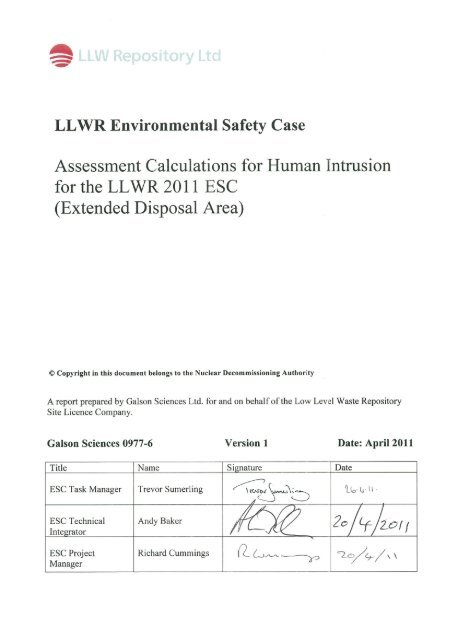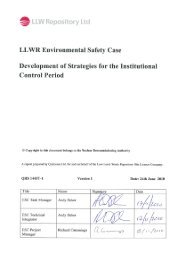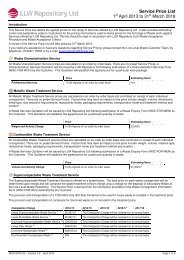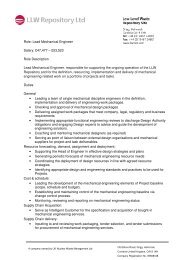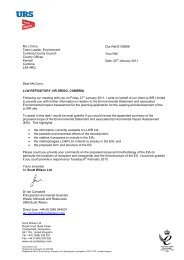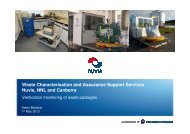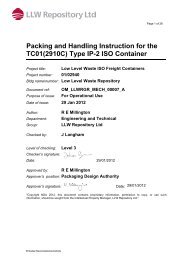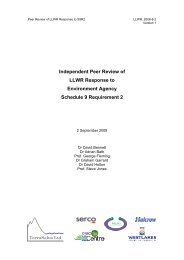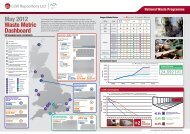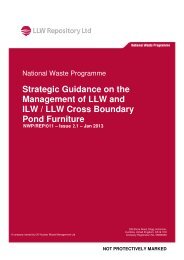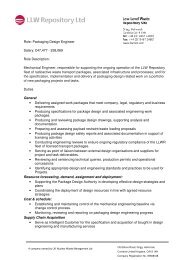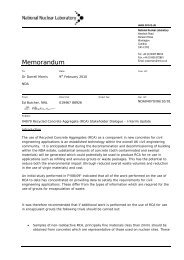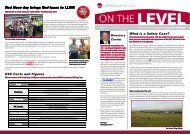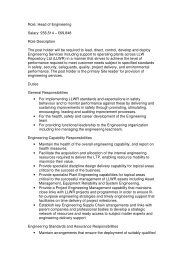Baldwin TD and Hicks TW, Assessment Calculations for Human ...
Baldwin TD and Hicks TW, Assessment Calculations for Human ...
Baldwin TD and Hicks TW, Assessment Calculations for Human ...
Create successful ePaper yourself
Turn your PDF publications into a flip-book with our unique Google optimized e-Paper software.
This page is left blank intentionally.
0977-6Version 1<strong>Assessment</strong> <strong>Calculations</strong> <strong>for</strong><strong>Human</strong> Intrusion <strong>for</strong> theLLWR 2011 ESC (ExtendedDisposal Area)T.D. <strong>Baldwin</strong> <strong>and</strong> T.W. <strong>Hicks</strong>21 March 2011GalsonS C I E N C E S L T D5 Grosvenor House, Melton Road, Oakham, Rutl<strong>and</strong> LE15 6AX, UKTel: +44 (1572) 770649 Fax: +44 (1572) 770650 www.galson-sciences.co.uk
0977-6Version 1<strong>Assessment</strong> <strong>Calculations</strong> <strong>for</strong><strong>Human</strong> Intrusion <strong>for</strong> theLLWR 2011 ESC (ExtendedDisposal Area)Report HistoryThis document has been prepared by Galson Sciences Limited <strong>for</strong> LLW Repository Ltd underPurchase Order 9020/4510275914. Version 1, draft 1, was issued on 17 January 2011. Thefinalised Version 1 has been produced:- to ensure consistency with the results of screening calculations that identifiedradionuclides to be included in LLWR post-closure radiological assessments;- to update radiological dose coefficients to ensure consistency with values presented inthe LLWR radiological h<strong>and</strong>book; <strong>and</strong>- in response to review comments from Trevor Sumerling (dated 25 February 2011) onVersion 1, draft 1.In addition, the report references have been revised <strong>for</strong> consistency with other LLWR 2011ESC reports.<strong>Assessment</strong> <strong>Calculations</strong> <strong>for</strong> <strong>Human</strong> Intrusion <strong>for</strong> the LLWR 2011 ESC (ExtendedDisposal Area).Report No.: Date: Principal Author:T.D. <strong>Baldwin</strong>0977-6,Version 121 March 2011 Sign…………………Date…………………Reviewed by:R.D. WilmotSign……………..…Date………………..Approved by:D.A. GalsonSign…………………Date…………………
0977-6Version 1Executive SummaryThe Low Level Waste Repository (LLWR) is undertaking a programme of workleading to the production of an Environmental Safety Case by 1 st May 2011 (the 2011ESC). The ESC will include an assessment of the consequences of human intrusioninto the repository as required by the environment agencies’ Guidance onRequirements <strong>for</strong> Authorisation <strong>for</strong> Near-surface Disposal Facilities <strong>for</strong> SolidRadioactive Wastes (NS-GRA). Previous work by the authors considered possiblecases of human intrusion into the repository <strong>and</strong> provided assessment calculations insupport of a demonstration – to be documented in the 2011 ESC – that the facilitymeets Requirement R7 of the NS-GRA (human intrusion after the period ofauthorisation). This report provides human intrusion assessment calculations <strong>for</strong> thecase in which the LLWR capacity is increased by the addition of an ExtendedDisposal Area (EDA).According to Requirement R7, the dose to any person during <strong>and</strong> after assumedintrusion should not exceed a guidance level in the range of around 3 mSv/year toaround 20 mSv/year. Values towards the lower end of this range are applicable toassessed exposures continuing over a period of years (prolonged exposures), whilevalues towards the upper end of the range are applicable to assessed exposures thatare only short term (transitory exposures).For these assessment calculations, the radiation dose to intruders, or to othersfollowing intrusion, has been calculated using a GoldSim implementation of a humanintrusion model <strong>for</strong> a range of possible intrusion events <strong>and</strong> potential exposurepathways. Where the exposure is short-term <strong>and</strong> directly related to the event(transitory exposures of no more than a few hours to weeks duration), doses arecalculated as dose from the event, or from a series of events that are assumed to occurwithin a single year. Where the exposure is prolonged, as could occur following anevent in which radionuclides are distributed in the accessible environment, doses arecalculated as annual doses.A cautiously realistic approach has been taken in defining intrusion cases <strong>and</strong>parameter values <strong>for</strong> the assessment calculations. Future human behaviour <strong>and</strong> thenature of future intrusions into the disposal facility are uncertain <strong>and</strong> unpredictable indetail. For this reason a representative range of possible human intrusion events hasbeen considered based on present-day technologies <strong>and</strong> credible future uses <strong>for</strong> thesite; geotechnical investigations, a housing development <strong>and</strong> a smallholding havebeen identified as requiring quantitative assessment.In addition, human intrusion events have been considered that are associated withactivities that might occur in the period during which the site is being eroded by thesea <strong>and</strong> access to the in situ waste would be possible <strong>for</strong>m the beach. Coastal erosionis expected to begin to erode the disposal facility on a timescale of a few hundreds tothous<strong>and</strong>s of years after present; this will reveal wastes <strong>and</strong> engineered barriermaterials, which could become targets <strong>for</strong> casual interest or exploitation. There<strong>for</strong>e,the dose to individuals involved in activities to examine or extract materials from theeroding facility has also been evaluated.Galson Sciences Ltd i 21 March 2011
0977-6Version 1<strong>Assessment</strong> calculations take account of in<strong>for</strong>mation on the vault waste inventories<strong>for</strong> the EDA <strong>and</strong> the engineered cap design <strong>for</strong> the closed facility:• Two alternative EDA vault inventory cases have been evaluated based ondifferent assumptions about future waste arisings <strong>and</strong> management of lowlevelwaste (LLW) in the UK: the Case A inventory includes LLW from Stage3 reactor decommissioning; Case B includes solid LLW associated with ‘newbuild’ nuclear power station construction, operation <strong>and</strong> decommissioning.Note that calculations <strong>for</strong> the trenches <strong>and</strong> vaults of the Reference DisposalArea (RDA) have not been reproduced in this report.• A 3-m-thick engineered cap has been assumed to be placed over the facility ina single dome design, achieved by using profiling material between the wastes<strong>and</strong> the cap. A minimum 1 m thickness of profile material will be placedabove the vault wastes.• Spatial variability of radionuclide activity, profile material thickness <strong>and</strong>several other waste<strong>for</strong>m <strong>and</strong> barrier properties have been addressed in themodel by defining <strong>and</strong> specifying parameter values at each location in a gridof elements. Note that a cautious approach has been taken <strong>for</strong> vault elementsin that the profile material above the vaults has not been taken into account(i.e., only the 3-m-thick cap has been assumed to be present).A conservatism in the assessment model is that leaching of radionuclides from thewaste<strong>for</strong>m in infiltrating rainwater <strong>and</strong> from materials that are exposed as a result ofintrusion has been neglected. This is pessimistic <strong>for</strong> more mobile long-livedradionuclides such as 14 C <strong>and</strong> 36 Cl; these nuclides dominate the site smallholder dosethrough the foodstuffs ingestion pathways.A general assumption of the 2011 ESC is that management <strong>and</strong> regulatory control ofthe site will be maintained until about 100 years after the last disposal to the facility.For the RDA considered in the previous report, this led to an assumption of siterelease at 2180; <strong>for</strong> the EDA, disposals continue until about 2130 <strong>and</strong> assumed siterelease (the end of the period of management <strong>and</strong> regulatory control <strong>and</strong> the pointfrom which intrusion into the facility is considered) is assumed to occur at 2230.Key findings regarding calculated doses from human intrusion into parts of the EDAare as follows:• For the geotechnical investigation intrusion events, even if an engineer isinvolved in multiple intrusions, the calculated dose does not challenge the20 mSv/year regulatory guidance value <strong>for</strong> transitory exposures, or even the3 mSv regulatory guidance value <strong>for</strong> prolonged exposure. Similarly, singleintrusions <strong>for</strong> construction <strong>and</strong> organised material recovery result in smallcalculated doses. Even if deeper excavations are required as part of largedevelopments (e.g. pile foundations several metres deep), the appropriatelyscaled dose would be much less than 20 mSv/year.• Inhalation ( 239 Pu <strong>and</strong> 240 Pu) <strong>and</strong> external irradiation ( 137 Cs in the short termfollowed by 94 Nb at later times) are the dominant exposure pathways <strong>for</strong> theGalson Sciences Ltd ii 21 March 2011
0977-6Version 1majority of the intrusion events considered. However, dose to the siteoccupier is dominated by exposure to radon (from 226 Ra <strong>and</strong> 234 U decay), <strong>and</strong>dose to the site smallholder is dominated by ingestion of 14 C <strong>and</strong> 36 Cl in plantmaterial <strong>and</strong> goat’s milk.• External irradiation exposure to 108m Ag, recently identified as requiringinclusion in post-closure radiological assessments <strong>for</strong> the LLWR, contributesup to a few per cent of total dose in the short term after closure.• Should the site not be eroded as expected, but exist in the very long term(10,000 years after disposal), then inhalation of radon, <strong>and</strong> the dose associatedwith exposure to its daughters, becomes significant <strong>for</strong> occupancy events:radon concentrations increase in the long term as radium is ingrown from thedecay of 234 U disposals via 230 Th. However, ingestion of 14 C <strong>and</strong> 36 Cl in plantmaterial <strong>and</strong> goat’s milk by the smallholder is the most significant of all theexposure pathways <strong>and</strong> events.• The calculated dose <strong>for</strong> human intrusion into the vaults <strong>for</strong> all events <strong>for</strong> theCase A <strong>and</strong> Case B inventories is similar.• Different radionuclides dominate dose calculations <strong>for</strong> the extended facilitycompared to the RDA assessed previously. The dominant radionuclides in theRDA case are typically 232 Th <strong>and</strong> daughters 228 Th <strong>and</strong> 228 Ra, rather than 239 Pu,240 Pu <strong>and</strong> 94 Nb, which dominate in the EDA calculations. In addition,ingestion of 14 C <strong>and</strong> 36 Cl in plant material dominates the calculated dose to thesmallholder <strong>for</strong> the extended facility, whereas radon exposure is the dominantpathway <strong>for</strong> the RDA. However, the maximum calculated annual doses <strong>for</strong>intrusion into the EDA <strong>for</strong> the Case A inventory are smaller than themaximum annual doses calculated <strong>for</strong> intrusion into the RDA <strong>for</strong> eachintrusion event considered.Requirement R7 of the NS-GRA also requires the operator to show that dosethresholds <strong>for</strong> severe deterministic injury to individual body tissues are unlikely to beexceeded as a result of human intrusion into the facility. Consistent with the UK’sHealth Protection Agency guidance, as discussed in the NS-GRA, deterministiceffects would need to be assessed if the estimated effective dose received over a yearor less is greater than 100 mSv. The human intrusion assessment calculations haveshown that estimated doses from intrusion into the facility do not exceed thisthreshold <strong>for</strong> considering deterministic effects.The GoldSim implementation of the human intrusion model has been subjected tocomprehensive <strong>and</strong> systematic verification checks throughout its development <strong>and</strong>application.Galson Sciences Ltd iii 21 March 2011
0977-6Version 1allows <strong>for</strong> the application of project-specific procedures. For the development <strong>and</strong>application of the human intrusion assessment model, the following project-specificprocedures have been applied:• 0977-PSP2 GoldSim Model Verification, which is designed to ensure that theGoldSim implementation of the human intrusion model is appropriatelyverified <strong>for</strong> use to conduct assessment calculations.• 0977-PSP3 GoldSim Model Parameter Values, which aims to ensure thatparameter values <strong>for</strong> the human intrusion assessment are appropriatelyjustified, approved <strong>and</strong> documented.• 0977-PSP4 GoldSim Model Management System, which ensures that modeldevelopments, data sources <strong>and</strong> details of the model parameters used arerecorded, so that each code run can be repeated <strong>and</strong> the results reproduced.The procedure also ensures that there is an audit trail of code runs <strong>and</strong> resultsusage in project deliverables, such as reports <strong>and</strong> presentations.1.3 Report Structure<strong>Hicks</strong> <strong>and</strong> <strong>Baldwin</strong> (2011) provided a review of potential future human intrusionevents, mathematical descriptions of radiological dose pathways <strong>for</strong> intruders <strong>and</strong>others following intrusion, a description of the implementation of the human intrusionassessment model in GoldSim (GoldSim, 2009; 2010), <strong>and</strong> the results of assessmentcalculations <strong>for</strong> reference <strong>and</strong> alternative radioactive waste inventories <strong>for</strong> thetrenches <strong>and</strong> vaults up to construction of Vault 14. To avoid repetition, this reportrefers to <strong>Hicks</strong> <strong>and</strong> <strong>Baldwin</strong> (2011) <strong>for</strong> the detail of work in these areas <strong>and</strong> onlyreports the developments <strong>and</strong> model changes implemented to carry out assessmentcalculations <strong>for</strong> the extended repository (Vaults 15 to 20). The same potential humanintrusion events are assessed <strong>for</strong> both the reference <strong>and</strong> the extended repository cases,<strong>and</strong> the mathematical descriptions <strong>for</strong> the radiological dose pathways are unchanged.Section 2 of this report identifies the human intrusion cases <strong>and</strong> exposure pathwaysconsidered in the assessment model. The treatment of spatial variability in the humanintrusion assessment is discussed in Section 3. Section 4 discusses verification of thehuman intrusion model implementation in GoldSim. Section 5 discusses theparameters that relate to waste disposals, facility design <strong>and</strong> the exposure pathwaymodels; parameter values used in the model are listed in Appendix A. Section 6presents the results of the human intrusion assessment dose calculations <strong>and</strong> Section 7provides conclusions.Galson Sciences Ltd 3 21 March 2011
0977-6Version 12 <strong>Human</strong> Intrusion Events <strong>and</strong> Exposure PathwaysIdentification <strong>and</strong> selection of the human intrusion events <strong>for</strong> assessment is discussedin Section 2 of <strong>Hicks</strong> <strong>and</strong> <strong>Baldwin</strong> (2011). The GoldSim implementation of thehuman intrusion model solves identical expressions of dose <strong>for</strong> each human intrusionevent at each grid location across the disposal facility (the model grid is discussed inSection 3). The exposure pathways evaluated <strong>for</strong> each event are summarised in Table2.1 <strong>and</strong> their incorporation into the GoldSim application is illustrated in Figures 4.1 to4.6 of <strong>Hicks</strong> <strong>and</strong> <strong>Baldwin</strong> (2011). The relevant mathematical dose expressions arepresented in Appendix B of <strong>Hicks</strong> <strong>and</strong> <strong>Baldwin</strong> (2011).Where the exposure is short-term <strong>and</strong> directly related to the event, doses arecalculated as dose from the event. Where the exposure is prolonged, doses arecalculated as annual doses. In both cases, the dose calculated is the sum of effectivedoses from external irradiation received from the event or annually, plus committedeffective doses from inhalation <strong>and</strong> ingestion of contaminated material during theevent or annually.The specification of parameter values <strong>for</strong> each human intrusion event is discussed inSection 6.2 of <strong>Hicks</strong> <strong>and</strong> <strong>Baldwin</strong> (2011) <strong>and</strong> a summary table of parameter values isprovided in Section 5.2 of this report. Note that the dose <strong>for</strong> each geotechnicalinvestigation event (B1) is calculated <strong>for</strong> a single event (borehole drilling or trial pitexcavation) at each grid location or the analysis of a single sample from each location.However, during the course of a geotechnical investigation, an engineer may beinvolved in drilling several boreholes, excavating several trial pits, or analysingseveral samples. Cases involving multiple intrusion events are described by <strong>Hicks</strong><strong>and</strong> <strong>Baldwin</strong> (2011, §6.2). The GoldSim evaluations of dose <strong>for</strong> single events may besummed to determine the dose from multiple intrusion events.Galson Sciences Ltd 4 21 March 2011
0977-6Version 1Table 2.1Exposure pathways modelled <strong>for</strong> each human intrusion event.Event/Exposure PathwayDescriptionEvent B1a: Geotechnical investigations – borehole drilling.Inhalation ofcontaminated dustIngestion ofcontaminatedmaterialExternal irradiationEvent B1b: Geotechnical investigations – trial pit excavation.Inhalation ofcontaminated dustIngestion ofcontaminatedmaterialExternal irradiationEvent B1c: Geotechnical investigations – laboratory analysis.Inhalation ofcontaminated dustIngestion ofcontaminatedmaterialExternal irradiationRadon <strong>and</strong> thoroninhalationEvent B3a: Housing development – construction.Inhalation ofcontaminated dustIngestion ofcontaminatedmaterialExternal irradiationEvent B3a: Housing development – occupancy.Inhalation ofcontaminated dustIngestion ofcontaminatedmaterialDust generated by a borehole intrusion into waste includes radioactivematerial. A worker inhales the dust during drilling activities.During drilling activities a worker ingests contaminated material as a resultof, <strong>for</strong> example, h<strong>and</strong>-to-mouth contact <strong>and</strong> licking of the lips.Contaminated material is left on the ground during drilling activities <strong>and</strong> aworker in proximity to this material is exposed to external irradiation.Dust generated by a trial pit excavation that intersects waste includesradioactive material. A worker inhales the dust during excavationactivities.During excavation activities a worker ingests contaminated material (e.g.through h<strong>and</strong>-to-mouth contact <strong>and</strong> licking of the lips).Contaminated material is left on the ground during excavation activities<strong>and</strong> a worker in proximity to this material is exposed to externalirradiation.Inspection of contaminated soil samples generates dust. The technicianinhales the dust during the analysis.During the analysis, the technician ingests contaminated material (e.g.through h<strong>and</strong>-to-mouth contact <strong>and</strong> licking of the lips).The analyst is exposed to external irradiation while inspectingcontaminated samples.The analyst is exposed to radon <strong>and</strong> thoron emanating from the sample.Concentrations of radon <strong>and</strong> thoron inhaled by the analyst depend on thelaboratory volume <strong>and</strong> ventilation rate.Excavations <strong>for</strong> a housing development intersect waste <strong>and</strong> generate dustthat includes radioactive material. A worker inhales the dust during theexcavation activities.During excavation activities a worker ingests contaminated material (e.g.through h<strong>and</strong>-to-mouth contact <strong>and</strong> licking of the lips).Contaminated material is left on the ground during excavation activities<strong>and</strong> a worker in proximity to this material is exposed to externalirradiation.Contaminated material is left on the ground at the site after construction ofa housing development. Wind action generates contaminated dust <strong>and</strong> asite occupant is exposed to the dust while outside.While outside (e.g. gardening), a site occupant ingests contaminatedmaterial (e.g. through h<strong>and</strong>-to-mouth contact <strong>and</strong> licking of the lips).Galson Sciences Ltd 5 21 March 2011
Event/Exposure PathwayExternal irradiationRadon inhalationEvent B7: Smallholding.Inhalation ofcontaminated dustIngestion ofcontaminatedmaterialExternal irradiationDescription0977-6Version 1The house is built on contaminated ground <strong>and</strong> contaminated material ispresent in garden soil. As a result, a site occupant is exposed to externalirradiation while indoors <strong>and</strong> outside. The concrete floor of the houseprovides some shielding from gamma radiation.The house occupant is exposed to radon emanating from contaminatedmaterial beneath the house.Contaminated material is left on the ground at the site after construction ofthe smallholding. The contaminated material is mixed with soil byploughing. Wind action generates contaminated dust <strong>and</strong> the smallholderis exposed to the dust while outside.The smallholder ingests contaminated foodstuffs as a result of growingcrops <strong>and</strong> keeping animals on the site. The smallholder also inadvertentlyingests contaminated soil while working outside.The house is built on contaminated ground <strong>and</strong> contaminated material ispresent in soil. As a result, a site occupant is exposed to externalirradiation while indoors <strong>and</strong> outside. The concrete floor of the houseprovides some shielding from gamma radiation.Radon inhalation The house occupant is exposed to radon emanating from contaminatedmaterial beneath the house.Event C1: In<strong>for</strong>mal scavenging.Inhalation ofcontaminated dustIngestion ofcontaminatedmaterialExternal irradiationEvent C2: Organised material recovery.Inhalation ofcontaminated dustIngestion ofcontaminatedmaterialExternal irradiationAt the time the site is being revealed by coastal erosion, a scavengercollects material from the site. While on site, the scavenger inhalescontaminated dust.The scavenger inadvertently ingests contaminated material (e.g. throughh<strong>and</strong>-to-mouth contact <strong>and</strong> licking of the lips).The scavenger is exposed to external irradiation while in proximity towastes revealed by erosion. The scavenger is also periodically exposed toexternal irradiation from items recovered from the site <strong>and</strong> kept at home.At the time the site is being revealed by coastal erosion, materials aretargeted <strong>for</strong> organised recovery. While on site, a worker inhalescontaminated dust.A worker inadvertently ingests contaminated material (e.g. through h<strong>and</strong>to-mouthcontact <strong>and</strong> licking of the lips).A worker is exposed to external irradiation while in proximity to wastesrevealed by erosion.Galson Sciences Ltd 6 21 March 2011
0977-6Version 13 Treatment of Spatial VariabilityThe impact of future human intrusion at any particular location in the disposal facilitywill depend on the local properties of the waste <strong>and</strong> barrier system <strong>and</strong> theirevolution, as well as the type of intrusion event. Radionuclide activities, wastevolumes, <strong>and</strong> waste<strong>for</strong>m <strong>and</strong> barrier properties will vary significantly across thevaults, <strong>and</strong> such variability requires consideration in the human intrusion assessmentcalculations. The approach to addressing spatial variability in the GoldSim model isoutlined in this section.3.1 Spatial Variability in Waste Activities <strong>and</strong> VolumesThe effects of spatial variability in radionuclide activities <strong>and</strong> waste volumes acrossthe vaults have been investigated in the human intrusion assessment by specifying amodelling solution grid across the facility. The approach involves assigningradionuclide activities <strong>and</strong> waste volumes to each grid element. The discretisationmethod <strong>and</strong> the treatment of radionuclide inventories <strong>and</strong> waste volumes areconsistent with the approach being developed <strong>for</strong> the separate assessment of theradiological impacts of coastal erosion (Towler et al., 2011).Past <strong>and</strong> future disposals of waste packages to the trenches <strong>and</strong> vaults in the RDA arediscussed in by <strong>Hicks</strong> <strong>and</strong> <strong>Baldwin</strong> (2011, §6.1.2). The discretisation of the wastesaimed to capture the variability in inventories <strong>and</strong> variability in package stack height.The approach led to the specification of spatially varying parameters in 44 regions ina model grid across the disposal area <strong>for</strong> the RDA.The engineering data provided by LLWR <strong>for</strong> the extended repository places the sixadditional vaults to the south-east of the RDA. Considering the uncertain nature ofthe variant inventories <strong>for</strong> the extended area, it was considered appropriate todiscretise the EDA at the vault scale, giving rise to six new regions (vaults 15 to 20)<strong>and</strong> resulting in a total of 50 regions in the model grid across the disposal area. Thisis shown in Figure 3.1. The rows indicated on the grid represent the following:Row A: Trenches 6 <strong>and</strong> 7, <strong>and</strong> Vaults 16 <strong>and</strong> 19Row B: Trenches 4 <strong>and</strong> 5Row C: Trench 1, <strong>and</strong> Vaults 15 <strong>and</strong> 18Row D: Trenches 2 <strong>and</strong> 3Row E: Eastern half of Vaults 8 to 14, <strong>and</strong> Vaults 17 <strong>and</strong> 20Row F: Western half of Vaults 8 to 14The numbers shown on the trench elements in Figure 3.1 indicate the bays included inthose elements. The vault locations in the grid are also indicated. Vaults 15 to 20 ofthe EDA have been allocated to Rows A, C <strong>and</strong> E in Columns 10 <strong>and</strong> 11 of the grid.Radionuclide activities (available per trench bay <strong>and</strong> per vault) <strong>and</strong> waste volumes areallocated to each grid element based on this partitioning (Figure 3.1).Galson Sciences Ltd 7 21 March 2011
0977-6Version 1The grid <strong>for</strong> the RDA was implemented in the GoldSim human intrusion model byallocating inventories <strong>and</strong> material properties to the RDA grid cells (<strong>Hicks</strong> <strong>and</strong><strong>Baldwin</strong>, 2011). The GoldSim implementation of the grid system <strong>for</strong> the EDA humanintrusion assessment calculations includes only the six EDA grid cells as indicated inFigure 3.2. Identical exposure pathway equations <strong>for</strong> each human intrusion event aresolved <strong>for</strong> each grid cell.3.2 Spatial Variability in Other ParametersSeveral other spatially variable parameters relating to facility design <strong>and</strong> wastematerial properties were also identified as requiring consideration in the humanintrusion assessment. These factors are summarised as follows:• Profile material thickness. The modelling approach enables the assessment totake account of the varying thickness of the profiling material between theengineered cap <strong>and</strong> wastes. The single dome design provides a substantialthickness of profiling material above a large area of the trenches, where thepotential <strong>for</strong> intrusion is greatly reduced.• Thickness of waste layer, which is important in determining the quantity ofmaterial encountered by borehole intrusions. In particular, the discretisationof the vaults captures the variability in waste package stack height withinvaults.• Waste density. There is significant variation in trench <strong>and</strong> vault wastedensities across the facility, which is captured by the discretisation approach.Galson Sciences Ltd 8 21 March 2011
0977-6Version 1Figure 3.1Grid (rows A to F <strong>and</strong> 1 to 11 columns) imposed on vaults <strong>and</strong> trenches to enable representation of spatial variability inradionuclide activity <strong>and</strong> waste<strong>for</strong>m <strong>and</strong> barrier properties. Bay numbers are shown <strong>for</strong> each trench grid cell. Distances along thegrid sides are in metres.Galson Sciences Ltd 9 21 March 2011
0977-6Version 1Figure 3.2GoldSim implementation of the human intrusion model; doses from identical intrusion events are calculated at each location.The EDA human intrusion model only considers the additional vaults (Vaults 15 to 20); the trenches <strong>and</strong> Vaults 8 to 14 wereconsidered by <strong>Hicks</strong> <strong>and</strong> <strong>Baldwin</strong> (2011) in the calculations <strong>for</strong> the RDA.Galson Sciences Ltd 10 21 March 2011
0977-6Version 14 Model VerificationImplementation of the GoldSim EDA human intrusion model has been subjected tocomprehensive <strong>and</strong> systematic verification checks as discussed below. Version 1.2 ofthe GoldSim EDA human intrusion model was used to produce the results presentedin Section 6.4.1 GoldSim Software Validation <strong>and</strong> VerificationThe pedigree of the GoldSim software is evident based on its development <strong>and</strong> useover a period of almost 20 years (see www.GoldSim.com). GoldSim has been usedby <strong>and</strong>/or <strong>for</strong> a diverse set of customers <strong>and</strong> clients, including government agencies inover 10 countries (such as the US Department of Energy, NASA, the NuclearRegulatory Commission, <strong>and</strong> the Cali<strong>for</strong>nia Department of Water Resources),research laboratories (including S<strong>and</strong>ia National Laboratories, Los Alamos NationalLaboratory, the Paul Scherrer Institute, <strong>and</strong> MIT), <strong>and</strong> commercial organisationsworldwide.Released versions of GoldSim are verified by the code developers. Duringverification, many test problems are executed <strong>and</strong> the results compared to expectedvalues.4.2 Verification of the <strong>Human</strong> Intrusion Model in GoldSimThe implementation of the human intrusion model in GoldSim was verified by <strong>Hicks</strong><strong>and</strong> <strong>Baldwin</strong> (2011). This verification process included:• Checking the implementation of radionuclide decay chains.• Checking the implementation of the dose expressions <strong>for</strong> each humanintrusion event by comparison with results obtained by implementing the sameequations in a Microsoft Excel spreadsheet.• Checking that the results reflected expectations of the magnitude <strong>and</strong> spatial<strong>and</strong> temporal variability of calculated dose based on underst<strong>and</strong>ings of thetrench <strong>and</strong> vault inventories <strong>and</strong> exposure pathway parameters (‘sense’checks).This study of the additional vaults has involved assessment of the same types ofhuman intrusion event as those assessed <strong>for</strong> the RDA, <strong>and</strong> the same radionuclidedependentdata have been used. There<strong>for</strong>e, it was considered unnecessary toundertake further verification tests of the implementation of the radionuclide decayequations <strong>and</strong> the dose expressions. However, checks were carried out to ensure thatGalson Sciences Ltd 11 21 March 2011
0977-6Version 1the activities <strong>and</strong> other vault-dependent parameters had been incorporated into theextended model correctly 1 .1 Note that the dose expressions represented in Version 1.2 of the model used to produce the resultspresented in this report <strong>and</strong> the data input process have not been modified since Version 1.1 wasproduced <strong>and</strong> this verification step has not been repeated <strong>for</strong> Version 1.2.Galson Sciences Ltd 12 21 March 2011
0977-6Version 15 Model ParametersThe specification of spatially variable parameters <strong>for</strong> the additional vaults <strong>and</strong>parameters <strong>for</strong> each human intrusion <strong>and</strong> occupancy event is presented in this section.5.1 Spatially Variable Parameters5.1.1 Radionuclide InventoryThe radionuclide inventories <strong>for</strong> predicted disposals to Vaults 15 to 20 have beenprovided in two spreadsheets (Case A: PIER V_2_3_a 19 11 10 ART AH.xls <strong>and</strong> CaseB: PIER V_2_3_b 19 11 10 ART AH.xls). These cases represent two differentinventory cases as described by Paulley (2011):• Case A considers wastes currently identified in WIDRAM 09 as destined <strong>for</strong>LLWR, “LLWR 2” or the planned geological disposal facility. This additionalinventory does not include waste streams currently anticipated to be disposedof at Dounreay or other identified sites, but could amount to an additionalpackaged waste volume of 573,000 m 3 . A large fraction of this additionalvolume is from Stage 3 reactor decommissioning.• Case B considers, in addition, the disposal of solid LLW associated with ‘newbuild’ construction, operation <strong>and</strong> decommissioning. The identified inventoryis speculative <strong>and</strong> probably a cautious overestimate, but acts as a baseline <strong>for</strong>analyses, <strong>and</strong> suggests an additional packaged waste volume of 730,000 m 3 .The radionuclide activities <strong>for</strong> each inventory case have been mapped to the modelgrid cells as indicated in Figure 3.1, <strong>and</strong> in Table A.2 (Case A) <strong>and</strong> Table A.3 (CaseB). Note that package stacking heights vary across the vaults to take account of spaceprovided by the cap profiling (see below).For the human intrusion assessment, the radionuclide activities <strong>for</strong> a vault have beenassumed to represent activities at the time of completion of disposals to that vault (i.e.radioactive decay to this time has been ignored). The vault filling completion dates,from which time decay has been assumed to begin, are as shown <strong>for</strong> each case inTable 5.1.Galson Sciences Ltd 13 21 March 2011
0977-6Version 1Table 5.1Vault completion dates (dates are rounded to the last year in whichdisposals are assumed to occur).Completion DateCase A Case BVault 15 2086 2087Vault 16 2092 2094Vault 17 2100 2101Vault 18 2106 2107Vault 19 2111 2112Vault 20 2127 21275.1.2 Other Vault ParametersFor the 2011 ESC, optimum use has been assumed to be made of LLWR capacityassociated with the vaults by emplacing packaged wastes to the maximum heightconsistent with the overall cap profile. Profiling material will fill the space betweenthe waste package stacks <strong>and</strong> the engineered cap. The stacking arrangement is asshown in Figure 5.1. For inventory Case A, waste packages are stacked up to sevenhigh in Vault 15, six high in Vaults 16 <strong>and</strong> 17, <strong>and</strong> up to four high in Vaults 18, 19<strong>and</strong> 20. For inventory Case B, waste packages are stacked up to eight high in Vaults15 <strong>and</strong> 16, seven high in Vault 17, <strong>and</strong> up to five high in Vaults 18, 19 <strong>and</strong> 20.Sufficient waste is available to fill the vaults to capacity <strong>for</strong> each inventory case.The thickness of cap <strong>and</strong> profile material above the stacks of waste packages will varyacross the vaults, with little profiling material being present above the waste packagestowards the edges of the package layers. A cautious approach has been taken <strong>for</strong> thehuman intrusion assessment in that, <strong>for</strong> each vault grid cell shown in Figure 3.1,intrusion is assumed to occur where the waste packages are stacked highest <strong>and</strong> wherethere is minimal profiling material. For the calculations only the 3-m-thickengineered cap 2 is assumed to be present as indicated in Table A.4. Thus, the amountof waste excavated by intrusive activities is maximised 3 .The free space volumes <strong>for</strong> waste in each vault, the maximum depth of waste in eachvault (based on an individual half-height International St<strong>and</strong>ards Organisation(HHISO) waste package height of 1.36 m) <strong>and</strong> the average bulk density of materials2 In a relatively late change to the engineering design, it was specified that there should be a minimumof 1 m thickness of profiling over the stacked waste in the vaults in order to buffer the cap against anydifferential settling effects (LLWR, 2011, §8.3.10). This additional 1 m of material is cautiouslyneglected in the human intrusion calculations presented here.3 Note that the addition of Vaults 15 to 20 would result in a greater thickness of profiling material beingpresent towards the southern end of the trenches, which would reduce the potential <strong>for</strong> human intrusioninto the trenches.Galson Sciences Ltd 14 21 March 2011
0977-6Version 1in the vaults after filling are shown in Table 5.2 (Egan, 2010; Paulley, 2010). Thestacking height changes across each vault to con<strong>for</strong>m with cap profiling <strong>and</strong> this isreflected in the variation in waste volumes <strong>and</strong> the maximum depth of waste acrossvault grid cells, as shown in Table A.4 <strong>and</strong> indicated in Figure 3.1.Waste densities <strong>for</strong> the additional vaults are assumed to be the same as calculated <strong>for</strong>Vaults 9 to 14. Material degradation will result in volumetric changes to the wastes<strong>and</strong> increases in bulk density. Paulley (2010) estimated the average bulk density ofmaterials will increase to 2,762 kg/m 3 after around 500 years <strong>and</strong> 2,812 kg/m 3 <strong>for</strong>fully degraded material. The human intrusion assessment is expected to be insensitiveto such changes in waste volume <strong>and</strong> density <strong>and</strong> there<strong>for</strong>e these changes have beenneglected. This is a cautious approach in that mixing of wastes with uncontaminatedmaterials is minimised <strong>for</strong> a specific depth of intrusion.Table 5.2 Additional vault waste properties. Data sourced from: Egan, 2010;Paulley, 2010; PIER V_2_3_a 19 11 10 ART AH.xls; PIER V_2_3_b 1911 10 ART AH.xls; <strong>and</strong> LLWR, LLWR Art 2010 Drawings, FutureVaults, Plan Showing HHISO Stacking – Case A, Revision C,7/06/2010 <strong>and</strong> Plan Showing HHISO Stacking – Case B, Revision C,13/07/2010.VaultInitialwastevolume(m 3 )Case AMaximumwastedepth (m)Initialwastevolume(m 3 )Case BMaximumwastedepth (m)Case A<strong>and</strong> BEstimatedbulkdensity(kg/m 3 )Vault 15 153,000 9.52 202,000 10.88 2,569Vault 16 98,000 8.16 148,000 10.88 2,569Vault 17 122,000 8.16 136,000 9.52 2,569Vault 18 72,000 5.44 83,000 6.8 2,569Vault 19 67,000 5.44 83,000 6.8 2,569Vault 20 61,020 5.44 78,000 6.8 2,569Galson Sciences Ltd 15 21 March 2011
0977-6Version 1Case ACase BFigure 5.1Additional vaults waste package stacking heights <strong>for</strong> inventory Case A <strong>and</strong> Case B (LLWR, 2011; LLWR Art 2010 Drawings,Future Vaults, Plan Showing HHISO Stacking – Case A, Revision C, 7/06/2010 <strong>and</strong> Plan Showing HHISO Stacking – Case B,Revision C, 13/07/2010).Galson Sciences Ltd 16 21 March 2011
0977-6Version 15.2 Intrusion EventsThe parameters <strong>for</strong> each human intrusion <strong>and</strong> occupancy event are discussed by <strong>Hicks</strong><strong>and</strong> <strong>Baldwin</strong> (2011, §6.2) <strong>and</strong> remain unchanged <strong>for</strong> this extended repositoryassessment. The key parameter values <strong>for</strong> each intrusion event <strong>and</strong> the associatedexposure pathways are summarised in Table 5.3.Galson Sciences Ltd 17 21 March 2011
0977-6Version 1Table 5.3Summary of key exposure pathway parameters <strong>for</strong> each intrusion event. The choice of these parameter values is discussed by<strong>Hicks</strong> <strong>and</strong> <strong>Baldwin</strong> (2011, §6.2).Intrusion parametersParameterB1aBoreholedrillerB1bTrial pitexcavatorB1cLaboratoryAnalystB3aConstructionworkerB3bHouseoccupantB7SmallholderIntrusion depth [m] 20 4.5 5 5Cross sectional area of intrusion [m 2 ] 0.025 2.3 400 50Extracted sample volume [m 3 ] 0.03Volume of mixed soil <strong>and</strong> excavated material [m 3 ] 2250Number of intrusion events [-] 5 20 25Inhalation pathwayC1ScavengerC2MaterialRecoveryworkerDust density [kg/m 3 ] 6E-07 6E-07 6E-07 6E-07 1E-07 1E-07 6E-07 6E-07Outdoor inhalation rate [m 3 /hr] 1.7 1.7 1.2 1.7 1.375 1.7 1.375 1.7Outdoor inhalation time [hr/yr] 16 1 2 80 1753.2 1461 50 40Ingestion pathwaySoil ingestion rate [kg/day] 0.00004 0.000005 0.00001 0.00004 0.000024 0.00002 0.000005 0.00004Soil ingestion time [day/yr] 2 1 1 10 365.25 365.25 50 5Crop ingestion rate [kg/yr] 250Goat’s milk ingestion rate [kg/yr] 215Egg ingestion rate [kg/yr] 20Pasture ingestion rate <strong>for</strong> goat [kg/yr] 500Soil ingestion rate <strong>for</strong> goat [kg/yr] 10Soil ingestion rate <strong>for</strong> hen [kg/yr] 1Galson Sciences Ltd 18 21 March 2011
0977-6Version 1External irradiationRadonParameterB1aBoreholedrillerB1bTrial pitexcavatorB1cLaboratoryAnalystB3aConstructionworkerB3bHouseoccupantB7SmallholderC1ScavengerC2MaterialRecoveryworkerOutdoor external irradiation time [hr/yr] 16 1 80 1753.2 1461 50 40Outdoor external irradiation scaling factor [-] 0.1 0.4 1 1 1 1 1Indoor external irradiation time [hr/yr] 2 7012.8 7305 365Indoor external irradiation scaling factor [-] 0.08 0.3 0.3 0.002Radon dose conversion factor [(Sv/h)/(Bq/m 3 )] 3.6E-09 7.13E-09 7.13E-09Thoron dose conversion factor [(Sv/h)/(Bq/m 3 )]9.1E-10Room ventilation rate [1/yr] 44000Room volume [m 3 ] 100Radon emanation coefficient [-] 0.2Thoron emanation coefficient [-] 0.2Galson Sciences Ltd 19 21 March 2011
0977-6Version 16 Results<strong>Calculations</strong> have been undertaken to evaluate potential doses from inadvertenthuman intrusion into the additional vaults <strong>for</strong> each of the two inventory casesdiscussed in Section 5.1. The starting point <strong>for</strong> evaluating the impacts of intrusion isthe time of withdrawal of regulatory control from the site, which is assumed to beabout 100 years after all engineering <strong>and</strong> decommissioning of active systems iscomplete <strong>and</strong> the site has been closed. For the Reference Disposal Area considered inthe previous report this led to an assumption of the end of the period of management<strong>and</strong> regulatory control at 2180. Assuming it takes 3 years to complete cappingfollowing completion of disposals to Vault 20 in the Extended Disposal Area, the siteclosure date <strong>for</strong> inventory cases A <strong>and</strong> B will be 2130, indicating an end toinstitutional control at 2230. Thus, doses from the geotechnical investigation events(B1), construction <strong>and</strong> occupancy events (B3) <strong>and</strong> smallholder event (B7) <strong>for</strong> theExtended Disposal Area have been evaluated from 2230.The earliest erosion contact of the site is assumed to be 300 years after present (AP),which is considered unlikely but credible. The latest time at which the site will becontacted by erosion, which includes the possibility that some measures are taken toinstall <strong>and</strong> maintain coastal defences <strong>for</strong> a period, is about 3,000 years AP. It isexpected that the site will be completely destroyed <strong>and</strong> dispersed by coastal erosionby about 5,000 years AP. Thus, the intrusion events are considered from the year2230 to the year 7000.The hazard presented by the disposal system in the longer term has also beenconsidered assuming that the facility is not eroded. Such calculations are importantbecause the inventory of some radionuclides will increase in the long term, notably226 Ra <strong>and</strong> its daughters growing in from 234 U via long-lived 230 Th. The longest time<strong>for</strong> which it is considered credible to continue calculations <strong>for</strong> the occupancy <strong>and</strong>smallholder events B3 <strong>and</strong> B7 is 10,000 years AP (i.e. until the year 12,000). Thestate of the disposal system cannot be predicted with any confidence on such longtimescales. There<strong>for</strong>e, the characteristics of the system, such as cap <strong>and</strong> profilethickness, are assumed to be the same as at closure. Note that the human intrusionassessment ignores any leaching of radionuclides in infiltrating water <strong>and</strong> subsequentmigration away from the site, which is very cautious on such long timescales.The following subsections present results <strong>for</strong> each intrusion event <strong>for</strong> inventory casesA <strong>and</strong> B. Results <strong>for</strong> all the intrusion events have been produced using Version 1.2 ofthe GoldSim EDA human intrusion model. The code runs are numbered 1.2.0 (CaseA) <strong>and</strong> 1.2.1 (Case B).Dose calculations are shown in terms of results at different GoldSim model grid cells,which map to trenches <strong>and</strong> vaults as indicated in Figure 3.2 <strong>and</strong> summarised in Figure6.1. The model grid was developed <strong>for</strong> the Reference Disposal Area human intrusionassessment calculations (columns 1 to 9) <strong>and</strong> has been used <strong>for</strong> the Extended DisposalArea (columns 10 <strong>and</strong> 11) to ensure consistency between the assessments.Galson Sciences Ltd 20 21 March 2011
0977-6Version 1Table 6.1Mapping of trenches <strong>and</strong> vaults to grid cells. <strong>Human</strong> intrusion into thegrey grid cells is reported by <strong>Hicks</strong> <strong>and</strong> <strong>Baldwin</strong> (2011); only theadditional vaults mapped in columns 10 <strong>and</strong> 11 are discussed here.1 2 3 4 5 6 7 8 9 10 11A Trenches 6 <strong>and</strong> 7B Trenches 4 <strong>and</strong> 5C Trench 1D Trenches 2 <strong>and</strong> 3Vault16Vault15Vault19Vault18EFVault 8 Vault 9Vault10Vaults11 &12Vault13Vault14Vault17Vault20Profiles of dose against time are shown <strong>for</strong> each intrusion event. These profiles showthe maximum dose from an event occurring at a given time; they are not profiles ofannual dose following an intrusion event at a specific time.6.1 Inventory Case AInventory Case A includes wastes currently identified in WIDRAM 09 as destined <strong>for</strong>LLWR, “LLWR 2” or the planned geological disposal facility.6.1.1 B1a – Geotechnical Investigations: Borehole DrillingFigure 6.1 <strong>and</strong> Figure 6.2 show the total dose to an engineer during a drilling intrusionat different locations across the facility in the year 2230 <strong>and</strong> in the year 7000,respectively.The highest calculated doses at 2230 are <strong>for</strong> intrusions at grid cells C10(1.4 x 10 -4 mSv) <strong>and</strong> A10 (1.1 x 10 -4 mSv), which relate to Vaults 15 <strong>and</strong> 16,respectively. As discussed in Sections 2 <strong>and</strong> 5.2, it has been assumed that a singledriller could be involved in drilling five boreholes at the site. If a single driller wasinvolved in drilling five boreholes into grid cell C10 (Vault 15) at 2230, the dosereceived by the driller would be 7.2 x 10 -4 mSv. The smallest dose would be received<strong>for</strong> boreholes drilled into grid cell A11 (4.8 x 10 -5 mSv); if five boreholes were drilledthere then the dose received by the driller would be 2.4 x 10 -4 mSv.Galson Sciences Ltd 21 21 March 2011
0977-6Version 1Vaults 15 <strong>and</strong> 16 (grid cells C10 <strong>and</strong> A10) contain high initial 239 Pu <strong>and</strong> 240 Puactivities <strong>and</strong> drilling into these cells would result in relatively high dose to theintruder via the dust inhalation pathway. Figure 6.3 <strong>and</strong> Figure 6.5 indicate thecontribution to dose of the main radionuclides <strong>for</strong> intrusions in grid cells A10 <strong>and</strong> C10occurring between 2230 <strong>and</strong> 7000. Figure 6.4 <strong>and</strong> Figure 6.6 show the dose fromeach exposure pathway. The potential dose from drilling at these locations (C10 <strong>and</strong>A10) is dominated by plutonium inhalation exposure.0.000160.000140.00012Dose (mSv)0.000100.000080.000060.000040.000020.00000A & B10C & D11E & FFigure 6.1Total dose to the driller (B1a) from a drilling intrusion at differentlocations in the year 2230 (Case A).Galson Sciences Ltd 22 21 March 2011
0977-6Version 10.000160.000140.00012Dose (mSv)0.000100.000080.000060.000040.000020.00000A & B10C & D11E & FFigure 6.2Total dose from drilling intrusion (B1a) at different locations in theyear 7000 (Case A).0.001Dose (mSv)0.00010.00001TotalE_ext_borehole[Cs137]E_inh_borehole[Am241fAm241]E_inh_borehole[Pu239fPu239]E_inh_borehole[Pu240fPu240]E_inh_borehole[Am241fPu241]E_inh_borehole[Pu238fPu238]E_ext_borehole[Ra226fRa226]E_ext_borehole[Ag108m]E_inh_borehole[Th228fTh232]E_ext_borehole[Th228fTh232]E_ext_borehole[Nb94]0.0000012000 3000 4000 5000 6000 7000Year (CE)Figure 6.3Main radionuclides contributing to dose <strong>for</strong> drilling intrusion (B1a) atgrid cell A10 (Vault 16) (Case A). The legend indicates exposurepathway, radionuclide contributing to dose (X) <strong>and</strong> source radionuclidein the inventory (Y, in <strong>for</strong>m [XfY]). (The horizontal time axisrepresents the year in the Current Era.)Galson Sciences Ltd 23 21 March 2011
0977-6Version 10.000120.000100.00008Dose (mSv)0.000060.00004TotalExternalIngestionInhalation0.000020.000002000 2500 3000 3500 4000 4500 5000 5500 6000 6500 7000Year (CE)Figure 6.4Dose from different exposure pathways <strong>for</strong> drilling intrusion (B1a) atgrid cell A10 (Vault 16) (Case A).0.001Dose (mSv)0.00010.00001TotalE_inh_borehole[Am241fAm241]E_ext_borehole[Cs137]E_inh_borehole[Pu239fPu239]E_inh_borehole[Pu240fPu240]E_inh_borehole[Am241fPu241]E_inh_borehole[Pu238fPu238]E_ext_borehole[Ra226fRa226]E_ext_borehole[Ag108m]E_ext_borehole[Nb94]E_inh_borehole[Th228fTh232]E_ext_borehole[Th228fTh232]E_inh_borehole[Th232fTh232]E_ing_borehole[Am241fAm241]0.0000012000 3000 4000 5000 6000 7000Year (CE)Figure 6.5Main radionuclides contributing to dose to a driller (B1a) <strong>for</strong> anintrusion at grid cell C10 (Vault 15) (Case A). The legend indicatesexposure pathway, radionuclide contributing to dose <strong>and</strong> sourceradionuclide in the inventory.Galson Sciences Ltd 24 21 March 2011
0977-6Version 10.000160.000140.00012Dose (mSv)0.000100.000080.00006TotalExternalIngestionInhalation0.000040.000020.000002000 3000 4000 5000 6000 7000Year (CE)Figure 6.6Dose from different exposure pathways <strong>for</strong> drilling intrusion (B1a) atgrid cell C10 (Vault 15) (Case A).6.1.2 B1b – Geotechnical Investigations: Trial Pit ExcavationsFigure 6.7 <strong>and</strong> Figure 6.8 show the total dose to a worker during a trial pit intrusion atdifferent locations across the facility at the year 2230 <strong>and</strong> at the year 7000,respectively.The assumed depth of the trial pit (4.5 m) results in intrusion into all vaults. Themaximum calculated dose resulting from trial pit excavation at 2230 is 1.5 x 10 -5 mSv<strong>and</strong> occurs in grid cell E11 (Vault 20). As shown in Figure 6.9 <strong>and</strong> Figure 6.10, afterdecay of 137 Cs, the dose to the intruder occurs primarily from 94 Nb via externalirradiation, <strong>and</strong> from 239 Pu via the dust inhalation exposure pathway.As discussed in Sections 2 <strong>and</strong> 5.2, it has been assumed that an engineer could beinvolved in excavating 20 trial pits at the site. If the 20 trial pits were excavated intoVault 20 at 2230, the dose received by the worker would be about 3.0 x 10 -4 mSv.However, if the trial pit locations were r<strong>and</strong>omly selected across the site, the totaldose received would be lower – the calculated dose received by a worker at differentlocations across the EDA at 2230 ranges from 7.3 x 10 -6 mSv in grid cell E10(Vault 17) to 1.5 x 10 -5 mSv in grid cell E11 (Vault 20). By the year 7000, thecalculated dose received at any location is less than about 3 x 10 -6 mSv.Galson Sciences Ltd 25 21 March 2011
0977-6Version 10.0000160.0000140.000012Dose (mSv)0.0000100.0000080.0000060.0000040.0000020.000000A & B10C & D11E & FFigure 6.7Total dose from trial pit intrusion (B1b) at different locations in theyear 2230 (Case A).0.0000160.0000140.000012Dose (mSv)0.0000100.0000080.0000060.0000040.0000020.000000A & B10C & D11E & FFigure 6.8Total dose from trial pit intrusion (B1b) at different locations in theyear 7000 (Case A).Galson Sciences Ltd 26 21 March 2011
0977-6Version 10.0001Dose (mSv)0.000010.000001TotalE_ext_trialpit[Cs137]E_inh_trialpit[Am241fAm241]E_ext_trialpit[Nb94]E_ext_trialpit[Ag108m]E_inh_trialpit[Pu239fPu239]E_inh_trialpit[Am241fPu241]E_inh_trialpit[Pu238fPu238]E_ext_trialpit[Sr90]0.00000012000 3000 4000 5000 6000 7000Year (CE)Figure 6.9Main radionuclides that contribute to dose <strong>for</strong> trial pit intrusion (B1b)at grid cell E11 (Vault 20). The legend indicates exposure pathway,radionuclide contributing to dose <strong>and</strong> source radionuclide in theinventory (Case A).0.0000160.0000140.000012Dose (mSv)0.0000100.0000080.000006TotalExternalIngestionInhalation0.0000040.0000020.0000002000 3000 4000 5000 6000 7000Year (CE)Figure 6.10Dose from different exposure pathways <strong>for</strong> trial pit intrusion (B1b) atgrid cell E11 (Vault 20) (Case A).Galson Sciences Ltd 27 21 March 2011
0977-6Version 16.1.3 B1c – Geotechnical Investigations: Laboratory AnalystFigure 6.11 <strong>and</strong> Figure 6.12 show the total dose to a technician examining a sample inthe year 2230 <strong>and</strong> in the year 7000, respectively, <strong>for</strong> investigations at differentlocations across the facility.The results are similar in <strong>for</strong>m to those <strong>for</strong> the trial pit digger, with the wastes inVault 15 (grid cell C10) generating the highest doses during sample analysis. Thehighest calculated dose at 2230 at grid cell C10 is 2.3 x 10 -5 mSv <strong>and</strong> the mostsignificant radionuclides in terms of contribution to dose are 239 Pu <strong>and</strong> 240 Pu,following 137 Cs <strong>and</strong> 241 Am decay (Figure 6.13). The key dose pathway is dustinhalation (Figure 6.14).As discussed in Sections 2 <strong>and</strong> 5.2, it has been assumed that one technician could beinvolved in the examination of 25 samples during a site investigation. If the 25samples were taken from grid cell C10, the dose received by the technician would beabout 5.9 x 10 -4 mSv. Realistically, the dose received would be lower than thisbecause samples would be taken from across the site; the calculated dose ranges from1.2 x 10 -5 mSv in grid cell E10 (Vault 17) to 2.3 x 10 -5 mSv in cell C10 (Vault 15) at2230.0.0000250.000020Dose (mSv)0.0000150.0000100.0000050.000000A & B10C & D11E & FFigure 6.11Total dose from laboratory analysis (B1c) of a sample taken fromgeotechnical investigations at different locations in the year 2230(Case A).Galson Sciences Ltd 28 21 March 2011
0977-6Version 10.0000250.000020Dose (mSv)0.0000150.0000100.0000050.000000A & B10C & D11E & FFigure 6.12Total dose from laboratory analysis (B1c) of a sample taken fromgeotechnical investigations at different locations in the year 7000(Case A).0.0001TotalE_inh_analyst[Am241fAm241]E_inh_analyst[Pu239fPu239]Dose (mSv)0.000010.0000010.00000012000 3000 4000 5000 6000 7000Year (CE)E_inh_analyst[Pu240fPu240]E_ext_analyst[Cs137]E_inh_analyst[Am241fPu241]E_Rn220_Th232_analystE_inh_analyst[Pu238fPu238]E_ext_analyst[Ra226fRa226]E_ext_analyst[Nb94]E_ext_analyst[Ag108m]E_inh_analyst[Th228fTh232]E_ext_analyst[Th228fTh232]E_inh_analyst[Th232fTh232]E_ext_analyst[Ra228fTh232]E_inh_analyst[U234fU234]E_inh_analyst[U238fU238]Figure 6.13Main radionuclides that contribute to dose <strong>for</strong> laboratory analysis(B1c) of a sample from grid cell C10 (Vault 15) (Case A). The legendindicates exposure pathway, radionuclide contributing to dose <strong>and</strong>source radionuclide in the inventory.Galson Sciences Ltd 29 21 March 2011
0977-6Version 10.0000350.0000300.000025Dose (mSv)0.0000200.0000150.000010TotalExternalIngestionInhalation0.0000050.0000002000 3000 4000 5000 6000 7000Year (CE)Figure 6.14Dose from different exposure pathways <strong>for</strong> laboratory analysis (B1c)of a sample from grid cell C10 (Vault 15) (Case A).6.1.4 B3a – Housing Development: ConstructionFigure 6.15 <strong>and</strong> Figure 6.16 show the total dose to a construction worker duringexcavation activities <strong>for</strong> a housing development at different locations across thefacility in the year 2230 <strong>and</strong> in the year 7000, respectively.The excavation <strong>for</strong> construction has been assumed to be 5 m deep (i.e. 0.5 m deeperthan assumed <strong>for</strong> a trial pit), which, based on assumptions about engineered cap <strong>and</strong>profiling material thickness, is sufficient to penetrate the vaults. The pattern ofcalculated doses in the vaults is similar to that <strong>for</strong> trial pit intrusions, except that thedose to the construction worker is about two orders of magnitude greater than thatcalculated <strong>for</strong> the trial pit worker, with a maximum of 3.0 x 10 -3 mSv in Vault 20 (cellE11) at 2230. The greater dose is largely due to the fact that excavation as part of ahousing development has been assumed to take 80 hours, whereas the excavation of atrial pit has been assumed to take one hour. The dominant exposure pathways areexternal irradiation (where 94 Nb is the greatest contributor to dose, following 137 Csdecay) <strong>and</strong> inhalation (where 239 Pu <strong>and</strong> 240 Pu are the greatest contributors to dose).The dose received by the worker ranges from 1.4 x 10 -3 mSv in grid cell E10(Vault 17) to 3.0 x 10 -3 mSv in cell E11 (Vault 20) at 2230. By the year 7000, thecalculated dose at each location has reduced by an order of magnitude.Galson Sciences Ltd 30 21 March 2011
0977-6Version 10.00350.00300.0025Dose (mSv)0.00200.00150.00100.00050.0000A & B10C & D11E & FFigure 6.15Total dose to a construction worker (B3a) during excavation <strong>for</strong> ahousing development in the year 2230 (Case A).0.00350.00300.0025Dose (mSv)0.00200.00150.00100.00050.0000A & B10C & D11E & FFigure 6.16Total dose to a construction worker (B3a) during excavation <strong>for</strong> ahousing development in the year 7000 (Case A).Galson Sciences Ltd 31 21 March 2011
0977-6Version 10.010.001TotalDose (mSv)0.0001E_ext_builder[Cs137]E_ext_builder[Nb94]E_ext_builder[Ag108m]E_inh_builder[Am241fAm241]E_inh_builder[Pu239fPu239]E_inh_builder[Am241fPu241]E_ext_builder[Sr90]E_inh_builder[Pu240fPu240]E_inh_builder[Pu238fPu238]0.000012000 3000 4000 5000 6000 7000Year (CE)Figure 6.17Main radionuclides that contribute to dose <strong>for</strong> construction worker(B3a) at grid cell E11 (Vault 20) (Case A). The legend indicatesexposure pathway, radionuclide contributing to dose <strong>and</strong> sourceradionuclide in the inventory.0.0040.0030.003Dose (mSv)0.0020.0020.001TotalExternalIngestionInhalation0.0010.0002000 3000 4000 5000 6000 7000Year (CE)Figure 6.18Dose from different exposure pathways <strong>for</strong> a construction worker(B3a) at grid cell E11 (Vault 20) (Case A).Galson Sciences Ltd 32 21 March 2011
0977-6Version 16.1.5 B3b – Housing Development: OccupancyFigure 6.19, Figure 6.20 <strong>and</strong> Figure 6.21 show the total calculated annual dose to anoccupant on a housing development at different locations across the facility in theyears 2230, 7000 <strong>and</strong> 12000, respectively.The housing development has been assumed to follow construction activities thathave left radioactively contaminated material at the surface. The maximum annualcalculated dose at 2230, resulting from occupancy of a house built on excavatedVault 15 (cell C10) wastes, is 2.6 x 10 -1 mSv. This dose is dominated by exposure toradon <strong>and</strong> its progeny as a result of the house being constructed on wastes that contain226 Ra (Figure 6.22 <strong>and</strong> Figure 6.23). Over time, as the dose contribution from 222 Rn(<strong>and</strong> its daughters) associated with 226 Ra disposals reduces, the inhalation of 222 Rnassociated with the decay of 234 U disposals (via 230 Th <strong>and</strong> 226 Ra) begins to dominate.The calculated dose ranges from 7.2 x 10 -2 mSv in grid cell A11 (Vault 19) to2.6 x 10 -1 mSv in grid cell C10 (Vault 15) at 2230. By the year 7000, the calculateddose at each location has reduced by almost an order of magnitude, only increasingslightly by the year 12000 to a maximum of 6.0 x 10 -2 mSv in grid cell C10 due toinhalation of radon associated with 234 U decay.0.300.25Dose (mSv)0.200.150.100.050.00A & B10C & D11E & FFigure 6.19Total annual dose to a site occupant (B3b) in the year 2230 (Case A).Galson Sciences Ltd 33 21 March 2011
0977-6Version 10.300.25Dose (mSv)0.200.150.100.050.00A & B10C & D11E & FFigure 6.20Total annual dose to a site occupant (B3b) in the year 7000 (Case A).0.300.25Dose (mSv)0.200.150.100.050.00A & B10C & D11E & FFigure 6.21Total annual dose to a site occupant (B3b) in the year 12,000 (Case A).Galson Sciences Ltd 34 21 March 2011
0977-6Version 11Dose (mSv)0.10.01TotalE_Rn222_Ra226_occupierE_ext_occupier_inside[Cs137]E_ext_occupier_outside[Cs137]E_ext_occupier_inside[Ra226fRa226]E_ext_occupier_inside[Ag108m]E_ext_occupier_inside[Nb94]E_ext_occupier_outside[Ra226fRa226]E_ext_occupier_outside[Ag108m]E_ext_occupier_outside[Nb94]E_ext_occupier_inside[Th228fTh232]E_ext_occupier_outside[Th228fTh232]E_Rn222_U234_occupier0.0012000 3000 4000 5000 6000 7000 8000 9000 10000 11000 12000Year (CE)Figure 6.22Main radionuclides that contribute to annual dose to a site occupant(B3b) at grid cell C10 (Vault 15) (Case A). The legend indicatesexposure pathway, radionuclide contributing to dose <strong>and</strong> sourceradionuclide in the inventory.0.300.250.20Dose (mSv)0.150.10TotalExternal (inside)External (outside)InhalationIngestionRn2220.050.002000 3000 4000 5000 6000 7000 8000 9000 10000 11000 12000Year (CE)Figure 6.23Annual dose from different exposure pathways <strong>for</strong> a site occupant(B3b) at grid cell C10 (Vault 15) (Case A).Galson Sciences Ltd 35 21 March 2011
0977-6Version 16.1.6 B7 – SmallholdingFigure 6.24, Figure 6.25 <strong>and</strong> Figure 6.26 show the total annual dose to a smallholderat different locations on the site in the years 2230, 7000 <strong>and</strong> 12000, respectively.Exposure via the foodstuff pathways dominates the total dose to the smallholder.This is due to exposure to 14 C in plant material <strong>and</strong>, to a lesser extent, exposure to 36 Clin plant material <strong>and</strong> exposure to 14 C <strong>and</strong> 36 Cl in goat’s milk (Figure 6.27). Vaults 15to 18 contain high 14 C activities <strong>and</strong> relatively low 234 U activities, unlike Vaults 8 to14, <strong>for</strong> which exposure to 222 Rn associated with the decay of 234 U dominates the totaldose (<strong>Hicks</strong> <strong>and</strong> <strong>Baldwin</strong>, 2011, Section 7.1.6). The maximum calculated annual dose(5.4 mSv) is observed in Vault 17 (cell E10) at 2230; the smallest annual dose is1.6 mSv in Vault 20 (cell F11) at this time. By the year 7000, the calculated annualdose in each grid cell is 3.4 mSv or less, <strong>and</strong> is no more than 2.4 mSv by the year12000.6.05.0Dose (mSv)4.03.02.01.00.0A & B10C & D11E & FFigure 6.24Total annual dose to a smallholder (B7) in the year 2230 (Case A).Galson Sciences Ltd 36 21 March 2011
0977-6Version 16.05.0Dose (mSv)4.03.02.01.00.0A & B10C & D11E & FFigure 6.25Total annual dose to a smallholder (B7) in the year 7000 (Case A).6.05.0Dose (mSv)4.03.02.01.00.0A & B10C & D11E & FFigure 6.26Total annual dose to a smallholder (B7) in the year 12000 (Case A).Galson Sciences Ltd 37 21 March 2011
0977-6Version 110Dose (mSv)10.1TotalE_ing_smallholder_GenericPlant[C14]E_ing_smallholder_GenericPlant[Cl36]E_ing_smallholder_GoatsMilk[C14]E_ing_smallholder_GoatsMilk[Cl36]E_ext_smallholder_inside[Cs137]E_ing_smallholder_GenericPlant[Sr90]E_Rn222_Ra226_smallholder0.012000 3000 4000 5000 6000 7000 8000 9000 10000 11000 12000Year (CE)Figure 6.27 Main radionuclides that contribute to annual dose to a smallholder (B7)at grid cell E10 (Vault 17) (Case A). The legend indicates exposure pathway,radionuclide contributing to dose <strong>and</strong> source radionuclide in the inventory.6.05.0Dose (mSv)4.03.02.01.0TotalExternal (inside)External (outside)InhalationIngestion (subtotal)Ingestion (Goat's milk)Ingestion (eggs)Ingestion (plants)Ingestion (soil)Rn2220.02000 3000 4000 5000 6000 7000 8000 9000 10000 11000 12000Year (CE)Figure 6.28Annual dose from different exposure pathways <strong>for</strong> a smallholder (B7)at grid cell E10 (Vault 17) (Case A).Galson Sciences Ltd 38 21 March 2011
0977-6Version 16.1.7 C1 – In<strong>for</strong>mal ScavengingFigure 6.29 <strong>and</strong> Figure 6.30 show the total annual dose to a scavenger on the site inthe years 2310 <strong>and</strong> 7000, respectively, during the period of site erosion by the sea.The results are similar in spread to those <strong>for</strong> a trial pit digger or construction worker,with the highest calculated annual dose corresponding with intrusion into grid cellE11 (Vault 20) at 2310 (1.2 x 10 -3 mSv). Inhalation of 239 Pu <strong>and</strong> 240 Pu contributesubstantially to the calculated dose, as found <strong>for</strong> the driller, but greater externalirradiation exposure time <strong>for</strong> the scavenger (see Table 5.3) means that 94 Nb is themost significant contributor to dose. Figure 6.31 <strong>and</strong> Figure 6.32 show the mainradionuclides contributing to dose <strong>and</strong> the exposure pathways <strong>for</strong> cell E11 (Vault 20).Only results after 2310, the earliest expected time of site contact by coastal erosion,are presented. The calculated annual dose ranges from 6.7 x 10 -4 mSv in grid cell E10(Vault 17) to 1.2 x 10 -3 mSv in cell E11 (Vault 20).0.00120.0010Dose (mSv)0.00080.00060.00040.00020.0000A & B10C & D11E & FFigure 6.29Total annual dose to a scavenger (C1) in the year 2310 (Case A).Galson Sciences Ltd 39 21 March 2011
0977-6Version 10.00120.0010Dose (mSv)0.00080.00060.00040.00020.0000A & B10C & D11E & FFigure 6.30Total annual dose to a scavenger (C1) in the year 7000 (Case A).0.010.001Dose (mSv)0.0001TotalE_ext_inf_scav_site[Cs137]E_ext_inf_scav_site[Nb94]E_ext_inf_scav_site[Ag108m]E_inh_inf_scav[Am241fAm241]E_inh_inf_scav[Pu239fPu239]E_inh_inf_scav[Am241fPu241]E_inh_inf_scav[Pu240fPu240]0.000012000 3000 4000 5000 6000 7000Year (CE)Figure 6.31Main radionuclides that contribute to annual dose to a scavenger (C1)at grid cell E11 (Vault 20) (Case A). The legend indicates exposurepathway, radionuclide contributing to dose <strong>and</strong> source radionuclide inthe inventory.Galson Sciences Ltd 40 21 March 2011
0977-6Version 10.00140.00120.0010Dose (mSv)0.00080.0006TotalExternalInhalationIngestion0.00040.00020.00002000 3000 4000 5000 6000 7000Year (CE)Figure 6.32Annual dose from different exposure pathways <strong>for</strong> a scavenger (C1) atgrid cell E11 (Vault 20) (Case A).6.1.8 C2 – Organised Material RecoveryFigure 6.33 <strong>and</strong> Figure 6.34 show the total dose to a worker during recovery ofmaterials exposed by coastal erosion in the years 2310 <strong>and</strong> 7000, respectively.The results are similar to those <strong>for</strong> the in<strong>for</strong>mal scavenger event (Section 6.1.7). Thehighest dose is calculated <strong>for</strong> grid cell E11 (Vault 20) at 2310 (9.9 x 10 -4 mSv) <strong>and</strong> isprimarily associated with exposure to 239 Pu, 94 Nb <strong>and</strong> 240 Pu. Similar to the in<strong>for</strong>malscavenger results, the main exposure pathways are inhalation <strong>and</strong> external irradiation.The smallest dose (5.6 x 10 -4 mSv) is calculated <strong>for</strong> grid cell E10 (Vault 17).Galson Sciences Ltd 41 21 March 2011
0977-6Version 1Dose (mSv)0.00100.00090.00080.00070.00060.00050.00040.00030.00020.00010.0000A & B10C & D11E & FFigure 6.33 Total dose to a worker during material recovery (C2) in the year 2310(Case A).0.00100.00090.0008Dose (mSv)0.00070.00060.00050.00040.00030.00020.00010.0000A & B10C & D11E & FFigure 6.34 Total dose to a worker during material recovery (C2) in the year 7000(Case A).Galson Sciences Ltd 42 21 March 2011
0977-6Version 16.1.9 SummaryCalculated maximum doses <strong>for</strong> each human intrusion event are summarised in Table6.2 <strong>and</strong> Table 6.3 <strong>for</strong> inventory Case A. Table 6.2 shows results <strong>for</strong> the short durationintrusion events. Table 6.3 shows calculated maximum annual doses <strong>for</strong> long termactivities.Table 6.2Summary maximum calculated doses <strong>for</strong> short-duration intrusionevents <strong>for</strong> inventory Case A.Case AMaximumdose (mSv)Location(cells)Time ofmaximum(year)B1aDrilling(5 boreholes)B1bTrial pit(20excavations)B1cLaboratoryanalysis(25 samples)B3aConstructionC2Materialrecovery7.2 x 10 -4 3.0 x 10 -4 5.9 x 10 -4 3.0 x 10 -3 9.9 x 10 -4Vault 15(C10)Vault 20 (E11) Vault 15(C10)Vault 20 (E11)Vault 20 (E11)2230 2230 2230 2230 2310Key pathway Inhalation Externalirradiation <strong>and</strong>inhalationDominantradionuclide(s)239 Pu <strong>and</strong> 240 Pu94 Nb <strong>and</strong> 239 PuInhalation239 Pu <strong>and</strong> 240 PuExternalirradiation <strong>and</strong>inhalation94 Nb, 239 Pu <strong>and</strong>240 PuExternalirradiation <strong>and</strong>inhalation94 Nb, 239 Pu <strong>and</strong>240 PuTable 6.3Summary maximum calculated doses <strong>for</strong> longer-term intrusionactivities <strong>for</strong> inventory Case A.Case AMaximum annual dose(mSv)B3bHouse occupancyB7SmallholdingC1Scavenging0.26 5.4 1.2 x 10 -3Location (cells) Vault 15 (C10) Vault 17 (E10) Vault 20 (E11)Time of maximum(year)2230 2230 2310Key pathway Radon Ingestion (plants <strong>and</strong>goat’s milk)Dominantradionuclide(s)222 Rn (from decay of226 Ra <strong>and</strong> 234 U)14 C <strong>and</strong> 36 ClExternal irradiation <strong>and</strong>inhalation94 Nb, 240 Pu <strong>and</strong> 239 PuGalson Sciences Ltd 43 21 March 2011
0977-6Version 16.2 Inventory Case BInventory Case B considers disposal of solid LLW associated with ‘new build’construction, operation <strong>and</strong> decommissioning. The change in inventory has very littleimpact on the calculated dose <strong>for</strong> human intrusion into the vaults <strong>for</strong> all eventscompared to the Case A results. Figure 6.35 to Figure 6.37 show the total dose <strong>for</strong> theconstruction worker, house occupant <strong>and</strong> smallholder, respectively, at differentlocations across the extended facility area in the year 2230. Calculated maximumdoses <strong>for</strong> each human intrusion event are summarised in Table 6.4 <strong>and</strong> Table 6.5 <strong>for</strong>inventory Case B.0.00250.0020Dose (mSv)0.00150.00100.00050.0000A & B10C & D11E & FFigure 6.35Total dose to a construction worker (B3a) during excavation <strong>for</strong> ahousing development in the year 2230 (Case B).Galson Sciences Ltd 44 21 March 2011
0977-6Version 10.250.20Dose (mSv)0.150.100.050.00A & B10C & D11E & FFigure 6.36Total annual dose to a site occupant (B3b) in the year 2230 (Case B).Dose (mSv)5.04.54.03.53.02.52.01.51.00.50.0A & B10C & D11E & FFigure 6.37Total annual dose to a smallholder (B7) in the year 2230 (Case B).Galson Sciences Ltd 45 21 March 2011
0977-6Version 1Table 6.4Summary maximum calculated doses <strong>for</strong> short-duration intrusionevents <strong>for</strong> inventory Case B.Case BMaximumdose (mSv)Location(cells)Time ofmaximum(year)B1aDrilling(5 boreholes)B1bTrial pit(20excavations)B1cLaboratoryanalysis(25 samples)B3aConstructionC2Materialrecovery7.4 x 10 -4 2.4 x 10 -4 5.5 x 10 -4 2.5 x 10 -3 9.9 x 10 -4Vault 15(C10)Vault 20 (E11) Vault 15(C10)Vault 20 (E11) Vault 15(C10)2230 2230 2230 2230 2310Key pathway Inhalation Externalirradiation<strong>and</strong> inhalationDominantradionuclide(s)239 Pu <strong>and</strong>240 Pu94 Nb, 239 Pu <strong>and</strong>240 PuInhalation239 Pu <strong>and</strong> 240 PuExternalirradiation94 NbInhalation <strong>and</strong>externalirradiation239 Pu <strong>and</strong> 94 NbTable 6.5Summary maximum calculated doses <strong>for</strong> longer-term intrusionactivities <strong>for</strong> inventory Case B.Case BMaximum annual dose(mSv)B3bHouse occupancyB7SmallholdingC1Scavenging0.24 4.7 1.1 x 10 -3Location (cells) Vault 15 (C10) Vault 17 (E10) Vault 15 (C10)Time of maximum(year)2230 2230 2310Key pathway Radon Ingestion (plants <strong>and</strong>goat’s milk)Dominantradionuclide(s)222 Rn (from decay of226 Ra <strong>and</strong> 234 U)14 C <strong>and</strong> 36 ClInhalation <strong>and</strong> externalirradiation239 Pu <strong>and</strong> 94 NbGalson Sciences Ltd 46 21 March 2011
0977-6Version 17 Conclusions<strong>Assessment</strong> calculations have been undertaken of the potential radiological hazardpresented by the LLWR if humans should inadvertently intrude into the facility in thefuture when controls on the site have lapsed or cease. The dose to intruders, or siteoccupants following intrusion, has been calculated using a GoldSim implementationof a human intrusion model <strong>for</strong> a range of possible intrusion events <strong>and</strong> potentialexposure pathways. <strong>Calculations</strong> <strong>for</strong> a Reference Disposal Area involving the LLWRtrenches <strong>and</strong> vaults up to the construction of Vault 14 have been reported by <strong>Hicks</strong><strong>and</strong> <strong>Baldwin</strong> (2011). This report provides calculations <strong>for</strong> an Extended Disposal Areainvolving extra waste capacity in Vaults 15 to 20.The assessment calculations have been undertaken in support of a demonstration – tobe documented in the 2011 ESC – that the facility meets Requirement R7 of theNS-GRA. According to Requirement R7, the dose to any person during <strong>and</strong> afterassumed intrusion should not exceed a guidance level in the range of around3 mSv/year to around 20 mSv/year. Values towards the lower end of this range areapplicable to assessed exposures continuing over a period of years (prolongedexposures), while values towards the upper end of the range are applicable to assessedexposures that are only short term (transitory exposures).A representative range of possible human intrusion events has been considered <strong>for</strong> theassessment based on present-day technologies <strong>and</strong> credible future uses <strong>for</strong> the site.The identification of intrusion events derives from a substantial body of work onhuman actions undertaken in support of the previous safety case <strong>for</strong> the LLWR,including expert elicitations <strong>and</strong> consideration of possible site uses. This process hasresulted in the identification of geotechnical investigations, a housing development<strong>and</strong> a smallholding as requiring quantitative assessment.In addition, human intrusion events have been considered that are associated withactivities that might occur in the period during which the site is being eroded by thesea <strong>and</strong> access to the in situ waste would be possible from the beach. Coastal erosionis expected to begin to erode the disposal facility on a timescale of a few hundreds tothous<strong>and</strong>s of years after present; this will reveal wastes <strong>and</strong> engineered barriermaterials, which could become targets <strong>for</strong> casual interest or exploitation. There<strong>for</strong>e,the dose to individuals involved in activities to examine or extract materials from theeroding facility has also been evaluated.<strong>Assessment</strong> calculations take account of in<strong>for</strong>mation on the vault waste inventories<strong>for</strong> the EDA <strong>and</strong> the engineered cap design <strong>for</strong> the closed facility:• Two alternative EDA vault inventory cases have been evaluated based ondifferent assumptions about future waste arisings <strong>and</strong> management of LLW inthe UK: the Case A inventory includes LLW from Stage 3 reactordecommissioning; Case B includes solid LLW associated with new buildconstruction, operation <strong>and</strong> decommissioning. <strong>Calculations</strong> <strong>for</strong> the trenches<strong>and</strong> vaults of the RDA have not been reproduced.Galson Sciences Ltd 47 21 March 2011
0977-6Version 1• A 3-m-thick engineered cap has been assumed to be placed over the facility ina single dome design, achieved by using profiling material between the wastes<strong>and</strong> the cap. A minimum 1 m thickness of profile material will be placedabove the vault wastes.• Spatial variability of radionuclide activity, profile material thickness <strong>and</strong>several other waste<strong>for</strong>m <strong>and</strong> barrier properties have been addressed in themodel by defining <strong>and</strong> specifying parameter values at each location in a gridof elements. Note that a cautious approach has been taken <strong>for</strong> vault elementsin that the profile material above the vaults has not been taken into account(i.e., only the 3-m-thick cap has been assumed to be present).A conservatism in the assessment model is that leaching of radionuclides from thewaste<strong>for</strong>m in infiltrating rainwater <strong>and</strong> from materials that are exposed as a result ofintrusion has been neglected. This is pessimistic <strong>for</strong> more mobile long-livedradionuclides such as 14 C <strong>and</strong> 36 Cl; these nuclides dominate the site smallholder dosethrough the foodstuffs ingestion pathways.The calculation of dose from inhalation of radon is based on a simple empirical modelthat relates average levels of radon in indoor air to average levels of radium in soils<strong>and</strong> rocks. The application of the model is pessimistic in that no credit has been taken<strong>for</strong> any mixing of excavated materials with uncontaminated materials. Suchconsiderations would result in reductions in calculated dose from radon inhalation.In general, the expressions of dose are simple linear functions of radionuclide activity.There<strong>for</strong>e, it has not been necessary to undertaken specific calculations to evaluate thesensitivity of results to parameter value variations because the effects of variationscan be scaled from the available results.A general assumption of the 2011 ESC is that management <strong>and</strong> regulatory control ofthe site will be maintained until about 100 years after the last disposal to the facility.For the RDA, considered in the previous report, this led to an assumption of siterelease at 2180; <strong>for</strong> the EDA, disposals continue until about 2130 <strong>and</strong> assumed siterelease (the end of the period of management <strong>and</strong> regulatory control <strong>and</strong> the pointfrom which intrusion into the facility is considered) is assumed to occur at 2230.Key findings regarding calculated doses from human intrusion into parts of the EDAare as follows:• For the geotechnical investigation intrusion events, even if an engineer isinvolved in multiple intrusions, the calculated dose does not challenge the20 mSv/year regulatory guidance value <strong>for</strong> transitory exposures, or even the3 mSv regulatory guidance value <strong>for</strong> prolonged exposure. Similarly, singleintrusions <strong>for</strong> construction <strong>and</strong> organised material recovery result in smallcalculated doses. Even if deeper excavations are required as part of largedevelopments (e.g. pile foundations several metres deep), the appropriatelyscaled dose would be much less than 20 mSv/year.• Inhalation ( 239 Pu <strong>and</strong> 240 Pu) <strong>and</strong> external irradiation ( 137 Cs in the short termfollowed by 94 Nb at later times) are the dominant exposure pathways <strong>for</strong> theGalson Sciences Ltd 48 21 March 2011
0977-6Version 1majority of the intrusion events considered. However, dose to the siteoccupier is dominated by exposure to radon (from 226 Ra <strong>and</strong> 234 U decay), <strong>and</strong>dose to the site smallholder is dominated by ingestion of 14 C <strong>and</strong> 36 Cl in plantmaterial <strong>and</strong> goat’s milk.• External irradiation exposure to 108m Ag, recently identified as requiringinclusion in post-closure radiological assessments <strong>for</strong> the LLWR (<strong>Baldwin</strong> <strong>and</strong><strong>Hicks</strong>, 2011), contributes up to a few per cent of total dose in the short termafter closure.• Should the site not be eroded as expected, but exist in the very long term(10,000 years after disposal), then inhalation of radon, <strong>and</strong> the dose associatedwith exposure to its daughters, becomes significant <strong>for</strong> occupancy events:radon concentrations increase in the long term as radium is ingrown from thedecay of 234 U disposals via 230 Th. However, ingestion of 14 C <strong>and</strong> 36 Cl in plantmaterial <strong>and</strong> goat’s milk by the smallholder is the most significant of all theexposure pathways <strong>and</strong> events.• The calculated dose <strong>for</strong> human intrusion into the vaults <strong>for</strong> all events <strong>for</strong> theCase A <strong>and</strong> Case B inventories is similar.• Different radionuclides dominate dose calculations <strong>for</strong> the extended facilitycompared to the reference waste management case (<strong>Hicks</strong> <strong>and</strong> <strong>Baldwin</strong>, 2011).The dominant radionuclides in the RDA are typically 232 Th <strong>and</strong> daughters228 Th <strong>and</strong> 228 Ra, rather than 239 Pu, 240 Pu <strong>and</strong> 94 Nb, which dominate in the EDAcalculations. In addition, ingestion of 14 C <strong>and</strong> 36 Cl in plant material dominatesthe calculated dose to the smallholder <strong>for</strong> the extended facility, whereas radonexposure is the dominant pathway <strong>for</strong> the RDA. However, the maximumcalculated annual doses <strong>for</strong> intrusion into the EDA <strong>for</strong> the Case A inventoryare smaller than the maximum annual doses calculated <strong>for</strong> intrusion in to theRDA <strong>for</strong> each intrusion event considered.Requirement R7 of the NS-GRA (Environment Agency et al., 2009, §6.3.40) alsorequires the operator to show that dose thresholds <strong>for</strong> severe deterministic injury toindividual body tissues are unlikely to be exceeded as a result of human intrusion intothe facility. Consistent with HPA guidance, as discussed in the NS-GRA(Environment Agency et al., 2009, §6.3.16), deterministic effects would need to beassessed if the estimated effective dose received over a year or less is greater than100 mSv. The human intrusion assessment calculations have shown that estimateddoses from intrusion into the facility do not exceed this threshold <strong>for</strong> consideringdeterministic effects.The GoldSim implementation of the human intrusion model has been subjected tocomprehensive <strong>and</strong> systematic verification checks throughout its development <strong>and</strong>application.Galson Sciences Ltd 49 21 March 2011
0977-6Version 18 References<strong>Baldwin</strong>, T.D. <strong>and</strong> <strong>Hicks</strong>, T.W., 2011. Radiological Hazard Index <strong>and</strong> Screening<strong>Calculations</strong> <strong>for</strong> the LLWR 2011 ESC. GSL Report 0977-5, Version 2, March 2011.Egan, M. 2010. Engineering Optimisation. Engineering Design Summary. ESCProject Memo LLWR/ESC/MeM(10)094, Issue 1.1, 2nd August 2010.Environment Agency, Northern Irel<strong>and</strong> Environment Agency <strong>and</strong> ScottishEnvironment Protection Agency, 2009. Near-surface Disposal Facilities on L<strong>and</strong> <strong>for</strong>Solid Radioactive Wastes: Guidance on Requirements <strong>for</strong> Authorisation, February2009.GoldSim, 2009. GoldSim User Guide. GoldSim Technology Group LLC. GoldSimTechnology Group LLC, version 10.0, February 2009.GoldSim, 2010. GoldSim Contaminant Transport User Guide. GoldSim TechnologyGroup LLC, version 5.1, January 2010.<strong>Hicks</strong>, T.W. <strong>and</strong> <strong>Baldwin</strong> T.D., 2011. <strong>Assessment</strong> <strong>Calculations</strong> <strong>for</strong> <strong>Human</strong> Intrusion<strong>for</strong> the LLWR 2011 ESC (Reference Disposal Area). GSL Report 0977-3 Version 2,March 2011.LLWR, 2011. Engineering Design. Report LLWR/ESC/R(11)10020, May 2011.Paulley, A., 2010. Average Density <strong>and</strong> Porosity of LLWR Vaults. ESC ProjectMemo. LLWR/ESC/MeM(10)099. 15 July 2010.Paulley, A. <strong>and</strong> Egan, M., 2011. LLWR Extended Disposal Area: DesignOptimisation. Quintessa Report QRS-1433ZE-1, Version 1.1, April 2011.Sumerling, T. 2009. <strong>Assessment</strong> of <strong>Human</strong> Intrusion in the 2011 ESC. ESC ProjectMemo LLWR/ESC/MeM(09)022, 19-05-09.Towler, G.H., Penfold, J.S.S., Limer, L.M.C. <strong>and</strong> Paulley, A., 2011. <strong>Assessment</strong><strong>Calculations</strong> <strong>for</strong> Coastal Erosion <strong>for</strong> the LLWR 2011 ESC. Quintessa Report, QRS-1443ZC-R1, Version 3, April 2011.Galson Sciences Ltd 50 21 March 2011
0977-6Version 1Appendix A - Parameter ValuesThis appendix contains the following data <strong>and</strong> parameter in<strong>for</strong>mation:Table A.1:Radioactive decay data <strong>and</strong> secular equilibrium assumptions.Table A.2: Inventories of radionuclides (TBq) <strong>for</strong> Case A.Table A.3: Inventories of radionuclides (TBq) <strong>for</strong> Case B.Table A.4:Spatially variable parameters.<strong>Human</strong> intrusion event <strong>and</strong> dose pathway parameters are recorded in the followingtables in Appendix C of <strong>Hicks</strong> <strong>and</strong> <strong>Baldwin</strong> (2011):Table C.8:Table C.9:Table C.10:Table C.11:Table C.12:Table C.13:Table C.14:Table C.15:Table C.16:Table C.17:Table C.18:Table C.19:Table C.20:Table C.21:Parameters <strong>for</strong> event B1a (borehole drilling).Parameters <strong>for</strong> event B1b (trial pit excavation).Parameters <strong>for</strong> event B1c (laboratory analysis).Parameters <strong>for</strong> event B3a (construction).Parameters <strong>for</strong> event B3b (site occupancy).Parameters <strong>for</strong> event B7 (farm/small holding).Parameters <strong>for</strong> event C1 (in<strong>for</strong>mal scavenging).Parameters <strong>for</strong> event C2 (local organised material recovery).Concentration <strong>and</strong> transfer factors.Dosimetry.Data on borehole drilling.Data on trial pit excavation.Data on borehole <strong>and</strong> trial pit sample analyses.Data on construction excavations.The model parameters are explained in <strong>Hicks</strong> <strong>and</strong> <strong>Baldwin</strong> (2011, Appendix B).Source references <strong>for</strong> parameter values are provided. Identification of parametervalues <strong>and</strong> their inclusion in GoldSim has been checked as part of a verificationprocess. Procedures have been implemented to guide <strong>and</strong> document this process inorder to ensure that each stage of parameter value identification <strong>and</strong> modelimplementation has been verified appropriately.Galson Sciences Ltd 51 21 March 2011
0977-6Version 1Table A.1Radioactive decay data <strong>for</strong> radionuclides modelled (<strong>Baldwin</strong> <strong>and</strong><strong>Hicks</strong>, 2011; ICRP, 2008). Species names used in the GoldSim modelare given. For example, Ac227fPu239 indicates 227 Ac ingrown fromthe decay of disposed 239 Pu.NuclideHalf-life(yrs)Species ID Daughter Daughters in secular equilibrium <strong>for</strong> evaluation ofexternal irradiation dose factorsAc227 21.772 Ac227fAc227 Fr223, At219, Bi215, Th227, Ra223, Rn219, Po215,Ac227fAm243Ac227fCm243Ac227fPa231Ac227fPu239Ac227fU235Pb211, Bi211, Tl207, Po211, Pb207Ag108m 4.18E+02 Ag108mAm241 432.2 Am241fAm241 Np237Am241fCm245Am241fPu241Am242m 141 Am242mfAm242m Cm242 Am242 (Am242 -> Pu242 not modelled), (Am242m ->Np238 -> Pu238 not modelled)Am243 7.37E+03 Am243fAm243 Pu239 Np239C14 5.70E+03 C14Cl36 3.01E+05 Cl36Cm242 4.46E-01 Cm242fAm242m Pu238Cm242fCm242Cm243 29.1 Cm243fCm243 Pu239Cm244 18.1 Cm244fCm244 Pu240Cm245 8.50E+03 Cm245fCm245 Pu241Cm246 4.76E+03 Cm246fCm246 Pu242Cm248 3.48E+05 Cm248fCm248 Pu244Co60 5.2713 Co60Cs135 2.30E+06 Cs135Cs137 30.1671 Cs137 Ba137mH3 12.32 H3I125 0.163 I125I129 1.57E+07 I129I131 0.02196 I131Mo93 4.00E+03 Mo93fMo93 Nb93mNb93m 16.13 Nb93mfMo93Nb93mfNb93mNb93mfZr93Nb94 2.03E+04 Nb94Nb95 0.0958 Nb95Ni63 100.1 Ni63Np237 2.14E+06 Np237fAm241 U233 Pa233Np237fCm245Np237fNp237Np237fPu241Galson Sciences Ltd 52 21 March 2011
0977-6Version 1NuclideHalf-life(yrs)Species ID Daughter Daughters in secular equilibrium <strong>for</strong> evaluation ofexternal irradiation dose factorsPa231 3.28E+04 Pa231fAm243 Ac227Pa231fCm243Pa231fPa231Pa231fPu239Pa231fU235Pb210 22.2 Pb210fAm242m Bi210, Po210, Tl206, Hg206Pb210fCm242Pb210fCm246Pb210fPb210Pb210fPu238Pb210fPu242Pb210fRa226Pb210fTh230Pb210fU234Pb210fU238Pu238 87.7 Pu238fAm242m U234Pu238fCm242Pu238fPu238Pu239 2.41E+04 Pu239fAm243 U235 (Pu239 -> U235m -> U235 not modelled)Pu239fCm243Pu239fPu239Pu240 6564 Pu240fCm244 U236Pu240fCm248Pu240fPu240Pu240fPu244Pu241 14.35 Pu241fCm245 Am241 (Pu241 -> U237 not modelled)Pu241fPu241Pu242 3.75E+05 Pu242fCm246 U238Pu242fPu242Pu244 8.00E+07 Pu244fCm248 Pu240 U240, Np240m (including Np240 branch)Pu244fPu244Ra226 1600 Ra226fAm242m Pb210 Rn222, Po218, Pb214, Bi214, Tl210, At218, Rn218,Ra226fCm242Ra226fCm246Ra226fPu238Ra226fPu242Ra226fRa226Ra226fTh230Ra226fU234Ra226fU238Po214Ra228 5.75 Ra228fCm244 Th228 Ac228Ra228fCm248Ra228fPu240Ra228fPu244Ra228fRa228Ra228fTh232Ra228fU236Galson Sciences Ltd 53 21 March 2011
0977-6Version 1NuclideHalf-life(yrs)Species ID Daughter Daughters in secular equilibrium <strong>for</strong> evaluation ofexternal irradiation dose factorsSr90 28.79 Sr90 Y90Tc99 2.11E+05 Tc99Th228 1.9116 Th228fCm244 Ra224, Rn220, Po216, Pb212, Bi212, Tl208, Po212Th228fCm248Th228fPu240Th228fPu244Th228fRa228Th228fTh228Th228fTh232Th228fU236Th229 7.34E+03 Th229fAm241 Ra225, Ac225, Fr221, At217, Bi213, Po213, Tl209,Th229fCm245Th229fNp237Th229fPu241Th229fTh229Th229fU233Pb209Th230 7.54E+04 Th230fAm242m Ra226Th230fCm242Th230fCm246Th230fPu238Th230fPu242Th230fTh230Th230fU234Th230fU238Th232 1.41E+10 Th232fCm244 Ra228Th232fCm248Th232fPu240Th232fPu244Th232fTh232Th232fU236U233 1.59E+05 U233fAm241 Th229U233fCm245U233fNp237U233fPu241U233fU233U234 2.46E+05 U234fAm242m Th230U234fCm242U234fCm246U234fPu238U234fPu242U234fU234U234fU238U235 7.04E+08 U235fAm243 Pa231 Th231U235fCm243U235fPu239U235fU235Galson Sciences Ltd 54 21 March 2011
0977-6Version 1NuclideHalf-life(yrs)Species ID Daughter Daughters in secular equilibrium <strong>for</strong> evaluation ofexternal irradiation dose factorsU236 2.34E+07 U236fCm244 Th232U236fCm248U236fPu240U236fPu244U236fU236U238 4.47E+09 U238fCm246 U234 Th234, Pa234m, Pa234U238fPu242U238fU238Zr93 1.53E+06 Zr93fZr93 Nb93mGalson Sciences Ltd 55 21 March 2011
Table A.2Inventory Case A0977-6Version 1Inventories of radionuclides (TBq) <strong>for</strong> Case A, with activities given atthe time of disposal.Mapping of activities to grid cells1 2 3 4 5 6 7 8 9 10 11A Trenches 6 <strong>and</strong> 7B Trenches 4 <strong>and</strong> 5C Trench 1D Trenches 2 <strong>and</strong> 3Vault16Vault15Vault19Vault18EFVault 8 Vault 9Vault10Vaults11 & 12Vault13Vault14Vault17Vault201 2 3 4 5 6 7 8 9Only the un-shaded cells in the above model grid are considered in thisassessment; the activities by nuclide <strong>for</strong> these cells <strong>for</strong> Case A are listedbelow.Ac227Ag108m10 11 10 11A 0.00E+00 0.00E+00 A 2.37E-03 2.41E-03BBC 0.00E+00 0.00E+00 C 4.16E-03 2.40E-03D DE 0.00E+00 0.00E+00 E 4.04E-03 2.46E-03FFAm241Am242m10 11 10 11A 3.01E-02 9.45E-03 A 0.00E+00 0.00E+00BBC 5.40E-02 1.14E-02 C 0.00E+00 0.00E+00D DE 1.72E-02 1.44E-02 E 0.00E+00 0.00E+00FFAm243C1410 11 10 11A 0.00E+00 0.00E+00 A 4.35E+00 1.06E+00BBC 0.00E+00 0.00E+00 C 5.41E+00 2.09E+00D DE 0.00E+00 0.00E+00 E 5.16E+00 8.36E-01FFGalson Sciences Ltd 56 21 March 2011
0977-6Version 1Cl36Cm24210 11 10 11A 5.31E-02 2.28E-02 A 6.07E-06 5.12E-06BBC 1.32E-01 1.21E-01 C 1.14E-05 6.09E-06D DE 2.58E-01 1.73E-02 E 7.90E-06 7.72E-06FFCm243Cm24410 11 10 11A 4.94E-07 6.29E-08 A 1.01E-04 8.24E-05BBC 1.33E-06 8.40E-08 C 2.05E-04 9.86E-05D DE 2.56E-07 0.00E+00 E 1.36E-04 1.19E-04FFCm245Cm24610 11 10 11A 0.00E+00 0.00E+00 A 0.00E+00 0.00E+00BBC 0.00E+00 0.00E+00 C 0.00E+00 0.00E+00D DE 0.00E+00 0.00E+00 E 0.00E+00 0.00E+00FFCm248Co6010 11 10 11A 0.00E+00 0.00E+00 A 2.54E-01 1.00E-02BBC 0.00E+00 0.00E+00 C 4.11E-01 1.54E-02D DE 0.00E+00 0.00E+00 E 1.53E-01 8.66E-03FFCs135Cs13710 11 10 11A 0.00E+00 0.00E+00 A 9.54E-01 6.36E-01BBC 0.00E+00 0.00E+00 C 1.68E+00 9.08E-01D DE 0.00E+00 0.00E+00 E 1.41E+00 9.59E-01FFGalson Sciences Ltd 57 21 March 2011
0977-6Version 1H3I12510 11 10 11A 5.29E+00 1.17E+00 A 0.00E+00 0.00E+00BBC 5.68E+00 4.67E+00 C 0.00E+00 0.00E+00D DE 8.58E+00 5.25E-01 E 0.00E+00 0.00E+00FFI129I13110 11 10 11A 6.00E-04 1.09E-05 A 0.00E+00 0.00E+00BBC 1.07E-03 1.39E-05 C 0.00E+00 0.00E+00D DE 3.79E-05 1.60E-05 E 0.00E+00 0.00E+00FFMo93Nb93m10 11 10 11A 3.15E-02 2.44E-01 A 2.13E-06 5.83E-04BBC 4.34E-02 9.63E-02 C 2.95E-06 1.25E-03D DE 5.92E-02 2.71E-01 E 3.74E-04 5.44E-06FFNb94Nb9510 11 10 11A 1.13E-03 4.43E-03 A 0.00E+00 0.00E+00BBC 3.12E-03 4.74E-03 C 0.00E+00 0.00E+00D DE 3.50E-03 3.11E-03 E 0.00E+00 0.00E+00FFNi63Np23710 11 10 11A 9.05E+00 6.72E+00 A 1.04E-04 8.50E-05BBC 1.84E+01 6.60E+00 C 2.11E-04 1.04E-04D DE 1.14E+01 6.66E+00 E 1.43E-04 1.24E-04FFGalson Sciences Ltd 58 21 March 2011
0977-6Version 1Pa231Pb21010 11 10 11A 0.00E+00 0.00E+00 A 1.12E-06 9.65E-07BBC 0.00E+00 0.00E+00 C 2.03E-06 1.15E-06D DE 0.00E+00 0.00E+00 E 1.49E-06 1.46E-06FFPu238Pu23910 11 10 11A 3.64E-03 1.86E-03 A 1.56E-02 3.27E-03BBC 6.74E-03 2.23E-03 C 2.74E-02 4.19E-03D DE 2.96E-03 2.77E-03 E 8.60E-03 4.40E-03FFPu240Pu24110 11 10 11A 9.12E-03 2.03E-03 A 1.85E-01 1.02E-01BBC 1.62E-02 2.50E-03 C 3.56E-01 1.22E-01D DE 3.62E-03 2.95E-03 E 1.63E-01 1.52E-01FFPu242Pu24410 11 10 11A 1.19E-06 1.03E-06 A 0.00E+00 0.00E+00BBC 2.17E-06 1.23E-06 C 0.00E+00 0.00E+00D DE 1.59E-06 2.13E-07 E 0.00E+00 0.00E+00FFRa226Ra22810 11 10 11A 1.88E-03 2.29E-05 A 0.00E+00 0.00E+00BBC 3.31E-03 2.72E-05 C 0.00E+00 0.00E+00D DE 2.02E-04 3.33E-05 E 0.00E+00 0.00E+00FFGalson Sciences Ltd 59 21 March 2011
0977-6Version 1Sr90Tc9910 11 10 11A 3.80E-01 3.14E-01 A 1.17E-02 6.55E-03BBC 6.83E-01 4.26E-01 C 1.70E-02 9.99E-03D DE 6.31E-01 4.71E-01 E 1.81E-02 6.45E-03FFTh228Th22910 11 10 11A 2.61E-06 2.25E-06 A 0.00E+00 0.00E+00BBC 4.75E-06 2.68E-06 C 0.00E+00 0.00E+00D DE 3.47E-06 3.11E-06 E 0.00E+00 0.00E+00FFTh230Th23210 11 10 11A 4.87E-07 4.06E-07 A 1.09E-03 5.25E-07BBC 9.44E-07 4.83E-07 C 1.90E-03 6.25E-07D DE 6.25E-07 8.41E-08 E 8.08E-07 1.09E-07FFU233U23410 11 10 11A 0.00E+00 0.00E+00 A 6.00E-03 8.42E-04BBC 0.00E+00 0.00E+00 C 1.05E-02 1.00E-03D DE 0.00E+00 0.00E+00 E 1.30E-03 1.26E-03FFU235U23610 11 10 11A 6.47E-04 7.39E-05 A 2.00E-04 1.22E-04BBC 1.19E-03 8.80E-05 C 3.59E-04 1.46E-04D DE 2.42E-04 1.11E-04 E 1.88E-04 1.84E-04FFGalson Sciences Ltd 60 21 March 2011
0977-6Version 1U238Zr9310 11 10 11A 6.12E-03 5.44E-04 A 8.65E-09 4.60E-09BBC 1.07E-02 6.48E-04 C 2.23E-09 6.14E-09D DE 9.75E-04 8.05E-04 E 1.93E-08 0.00E+00FFGalson Sciences Ltd 61 21 March 2011
Table A.3Inventory Case B0977-6Version 1Inventories of radionuclides (TBq) <strong>for</strong> Case B, with activities given atthe time of disposal.Mapping of activities to grid cells1 2 3 4 5 6 7 8 9 10 11A Trenches 6 <strong>and</strong> 7B Trenches 4 <strong>and</strong> 5C Trench 1D Trenches 2 <strong>and</strong> 3Vault16Vault15Vault19Vault18EFVault 8 Vault 9Vault10Vaults11 & 12Vault13Vault14Vault17Vault201 2 3 4 5 6 7 8 9Only the un-shaded cells in the above model grid are considered in thisassessment; the activities by nuclide <strong>for</strong> these cells <strong>for</strong> Case B are listedbelow.Ac227Ag108m10 11 10 11A 0.00E+00 0.00E+00 A 6.97E-03 2.37E-03BBC 0.00E+00 0.00E+00 C 1.37E-02 3.11E-03D DE 0.00E+00 0.00E+00 E 5.91E-03 2.82E-03FFAm241Am242m10 11 10 11A 2.91E-02 9.48E-03 A 3.88E-06 3.78E-06BBC 6.31E-02 1.12E-02 C 1.52E-07 5.35E-06D DE 1.36E-02 1.25E-02 E 5.83E-06 1.04E-05FFAm243C1410 11 10 11A 1.58E-07 0.00E+00 A 5.50E+00 9.94E-01BBC 4.06E-07 3.41E-08 C 7.15E+00 1.20E+00D DE 9.09E-08 0.00E+00 E 4.64E+00 6.99E-01FFGalson Sciences Ltd 62 21 March 2011
0977-6Version 1Cl36Cm24210 11 10 11A 6.17E-02 1.98E-02 A 1.87E-04 5.14E-06BBC 1.60E-01 4.84E-02 C 4.73E-04 4.47E-05D DE 3.20E-01 1.73E-02 E 1.10E-04 6.65E-06FFCm243Cm24410 11 10 11A 4.17E-06 3.78E-08 A 1.32E-04 8.12E-05BBC 1.08E-05 8.91E-07 C 2.44E-04 9.95E-05D DE 2.20E-06 0.00E+00 E 1.17E-04 1.02E-04FFCm245Cm24610 11 10 11A 0.00E+00 0.00E+00 A 0.00E+00 0.00E+00BBC 0.00E+00 0.00E+00 C 0.00E+00 0.00E+00D DE 0.00E+00 0.00E+00 E 0.00E+00 0.00E+00FFCm248Co6010 11 10 11A 0.00E+00 0.00E+00 A 1.63E+02 1.22E+02BBC 0.00E+00 0.00E+00 C 4.07E+01 1.46E+02D DE 0.00E+00 0.00E+00 E 1.66E+02 1.49E+02FFCs135Cs13710 11 10 11A 0.00E+00 0.00E+00 A 1.31E+00 7.14E-01BBC 0.00E+00 0.00E+00 C 2.05E+00 9.39E-01D DE 0.00E+00 0.00E+00 E 1.38E+00 9.27E-01FFGalson Sciences Ltd 63 21 March 2011
0977-6Version 1H3I12510 11 10 11A 1.84E+01 1.16E+01 A 0.00E+00 0.00E+00BBC 1.26E+01 1.69E+01 C 0.00E+00 0.00E+00D DE 2.74E+01 2.49E+01 E 0.00E+00 0.00E+00FFI129I13110 11 10 11A 4.16E-04 1.09E-05 A 6.33E-03 0.00E+00BBC 1.29E-03 1.35E-05 C 1.62E-02 1.37E-03D DE 1.88E-05 1.38E-05 E 3.64E-03 0.00E+00FFMo93Nb93m10 11 10 11A 5.97E-02 2.20E-01 A 1.96E-02 1.67E-02BBC 5.29E-02 1.45E-01 C 2.95E-03 2.28E-02D DE 5.43E-02 2.51E-01 E 2.44E-02 3.19E-02FFNb94Nb9510 11 10 11A 5.01E-03 5.42E-03 A 9.90E-03 0.00E+00BBC 4.12E-03 8.09E-03 C 2.54E-02 2.14E-03D DE 7.08E-03 5.79E-03 E 5.69E-03 0.00E+00FFNi63Np23710 11 10 11A 8.01E+01 5.36E+01 A 1.30E-04 8.45E-05BBC 4.38E+01 6.34E+01 C 2.41E-04 1.02E-04D DE 7.39E+01 6.39E+01 E 1.24E-04 1.07E-04FFGalson Sciences Ltd 64 21 March 2011
0977-6Version 1Pa231Pb21010 11 10 11A 0.00E+00 0.00E+00 A 1.36E-06 9.69E-07BBC 0.00E+00 0.00E+00 C 2.29E-06 1.13E-06D DE 0.00E+00 0.00E+00 E 1.32E-06 1.25E-06FFPu238Pu23910 11 10 11A 3.69E-03 1.86E-03 A 1.62E-02 3.15E-03BBC 7.89E-03 2.20E-03 C 3.19E-02 4.18E-03D DE 2.59E-03 2.38E-03 E 5.49E-03 3.79E-03FFPu240Pu24110 11 10 11A 7.68E-03 2.01E-03 A 2.00E-01 1.02E-01BBC 1.94E-02 2.46E-03 C 4.32E-01 1.22E-01D DE 3.01E-03 2.54E-03 E 1.46E-01 1.31E-01FFPu242Pu24410 11 10 11A 1.46E-06 9.83E-07 A 0.00E+00 0.00E+00BBC 2.45E-06 1.21E-06 C 0.00E+00 0.00E+00D DE 1.41E-06 5.02E-08 E 0.00E+00 0.00E+00FFRa226Ra22810 11 10 11A 1.48E-03 2.29E-05 A 0.00E+00 0.00E+00BBC 3.96E-03 2.68E-05 C 0.00E+00 0.00E+00D DE 4.98E-05 2.86E-05 E 0.00E+00 0.00E+00FFGalson Sciences Ltd 65 21 March 2011
0977-6Version 1Sr90Tc9910 11 10 11A 4.98E-01 3.14E-01 A 1.87E-02 5.81E-03BBC 7.76E-01 4.01E-01 C 2.05E-02 1.03E-02D DE 5.59E-01 4.05E-01 E 1.53E-02 6.86E-03FFTh228Th22910 11 10 11A 3.18E-06 2.25E-06 A 0.00E+00 0.00E+00BBC 5.35E-06 2.64E-06 C 0.00E+00 0.00E+00D DE 3.07E-06 2.65E-06 E 0.00E+00 0.00E+00FFTh230Th23210 11 10 11A 5.85E-07 3.87E-07 A 7.05E-04 5.00E-07BBC 1.06E-06 4.75E-07 C 2.31E-03 6.15E-07D DE 5.54E-07 1.98E-08 E 7.16E-07 2.56E-08FFU233U23410 11 10 11A 0.00E+00 0.00E+00 A 4.44E-03 8.44E-04BBC 0.00E+00 0.00E+00 C 1.26E-02 9.88E-04D DE 0.00E+00 0.00E+00 E 1.15E-03 1.08E-03FFU235U23610 11 10 11A 6.57E-04 7.41E-05 A 2.10E-04 1.23E-04BBC 1.38E-03 8.66E-05 C 4.14E-04 1.43E-04D DE 1.15E-04 9.56E-05 E 1.67E-04 1.58E-04FFGalson Sciences Ltd 66 21 March 2011
0977-6Version 1U238Zr9310 11 10 11A 4.52E-03 5.44E-04 A 1.90E-08 2.76E-09BBC 1.29E-02 6.39E-04 C 2.44E-09 7.98E-09D DE 7.59E-04 6.93E-04 E 8.90E-09 0.00E+00FFGalson Sciences Ltd 67 21 March 2011
0977-6Version 1Table A.4Spatially variable parameters in the human intrusion model.V waste Waste volume (m 3 ) (From PIER V_2_3_a 19 11 10 ART AH.xls <strong>and</strong> PIER V_2_3_b19 11 10 ART AH.xls)Case A inventoryCase B inventory10 11 10 11AA9.80E+04 6.70E+04BB1.48E+05 8.30E+04CC1.53E+05 7.20E+04DD2.02E+05 8.30E+04EE1.22E+05 6.10E+04FF1.36E+05 7.80E+04d cap Cap thickness (m) (From LLWR, Drawing ESC 2010 ART-04 Revision D, Crosssections HA1 <strong>and</strong> HA2 - Case A, dated 7/10/2010)Case A <strong>and</strong> B Inventories10 11AB3.00E+00 3.00E+00CD3.00E+00 3.00E+00EF3.00E+00 3.00E+00d wWaste thickness (m) (From LLWR, Drawing ESC 2010 ART-03 Revision C, Planshowing HHISO stacking - Case A, dated 7/06/2010, <strong>and</strong> Drawing ESC 2010 ART-13 Revision C, Plan showing HHISO stacking - Case B, dated 13/07/2010)Case A inventoryCase B inventory10 11 10 11AA8.16E+00 5.44E+00BB1.09E+01 6.80E+00CC9.52E+00 5.44E+00DD1.09E+01 6.80E+00EE8.16E+00 5.44E+00FF9.52E+00 6.80E+00ρ w Waste density (kg/m 3 ) (Paulley, 2010)Case A <strong>and</strong> B Inventories10 11AB2.57E+03 2.57E+03CD2.57E+03 2.57E+03EF2.57E+03 2.57E+03Galson Sciences Ltd 68 21 March 2011
0977-6Version 1f inh Inhalable fraction of dustCase A <strong>and</strong> B Inventories10 11AB1.00E+00 1.00E+00CD1.00E+00 1.00E+00EF1.00E+00 1.00E+00Galson Sciences Ltd 69 21 March 2011


